Transforming LCT Pegmatite Targeting Models into AI-Powered Predictive Maps of Lithium Potential for Western Australia and Ontario: Approach, Results and Implications
Abstract
:1. Introduction
| Project | Province | Ore (Mt) | Grade (% Li2O) | Li2O (kt) | Status | Owner |
|---|---|---|---|---|---|---|
| Greenbushes | YC | 445.5 | 1.48 | 6547 | Operating | Albemarle/Tianqi/IGO |
| Pilgangoora | PC | 413.9 | 1.16 | 4802 | Operating | Pilbara Minerals |
| Andover | PC | 240.0 | 1.50 | 3600 | Exploration | SQM/Hancock Prospecting) |
| Mt Holland | YC | 186.0 | 1.53 | 2846 | Operating | SQM/Wesfarmers |
| Wodgina | PC | 217.4 | 1.16 | 2517 | Operating | Albemarle/Mineral Resources |
| Kathleen Valley | YC | 156.0 | 1.35 | 2100 | Operating | Liontown Resources |
| Mt Marion | YC | 64.8 | 1.43 | 924 | Operating | Ganfeng/Mineral Resources |
| Tabba Tabba | PC | 74.1 | 1.00 | 740 | Pre-feasibility | Wildcat Resources |
| Manna | YC | 51.6 | 1.00 | 515 | Pre-feasibility | Global Lithium Resources |
| Bald Hill | YC | 26.5 | 0.97 | 256 | Operating | Lithco No. 2 |
| Malinda | GO | 24.7 | 0.98 | 243 | Exploration | Delta Lithium |
| Marble Bar | PC | 18.0 | 1.00 | 180 | Exploration | Global Lithium Resources |
| Mt Ida | YC | 14.6 | 1.22 | 178 | Exploration | Delta Lithium |
| Mt Cattlin | YC | 13.3 | 1.29 | 172 | Operating | Arcadium Lithium |
| Buldania | YC | 15.0 | 0.97 | 145 | Exploration | Liontown Resources |
| Dome North | YC | 11.1 | 1.15 | 128 | Scoping | Develop Global |
| Split Rocks | YC | 11.9 | 0.72 | 86 | Exploration | Zenith Minerals |
| Mt Edwards | YC | 2.0 | 0.69 | 13 | Exploration | WIN Metals |
| Niobe | YC | 4.6 | 0.07 | 3 | Exploration | Aldoro Resources |
| King Tamba | YC | 5.0 | 0.05 | 3 | Exploration | Krakatoa Resources |
| Totals | 1996 | 25,998 |
| Project | Province | Ore (Mt) | Grade (% Li2O) | Li2O (kt) | Status | Owner |
|---|---|---|---|---|---|---|
| PAK | SC | 58.5 | 1.49 | 871 | Feasibility | Frontier Lithium/Mitsubishi |
| Separation Rapids | SC | 12.9 | 1.36 | 175 | Exploration | Avalon/SCR-Sibelco |
| Georgia Lake | SC | 14.8 | 0.91 | 93 | Pre-Feasibility | RockTech Lithium |
| Root Bay | SC | 10.1 | 1.29 | 130 | Exploration | Green Technology Metals |
| Seymour Lake | SC | 10.3 | 1.03 | 106 | Feasibility | Green Technology Metals |
| Mavis Lake | SC | 8.0 | 1.07 | 86 | Exploration | Critical Resources |
| McCombe | SC | 4.5 | 1.01 | 45 | Exploration | Green Technology Metals |
| Totals | 119 | 1549 |

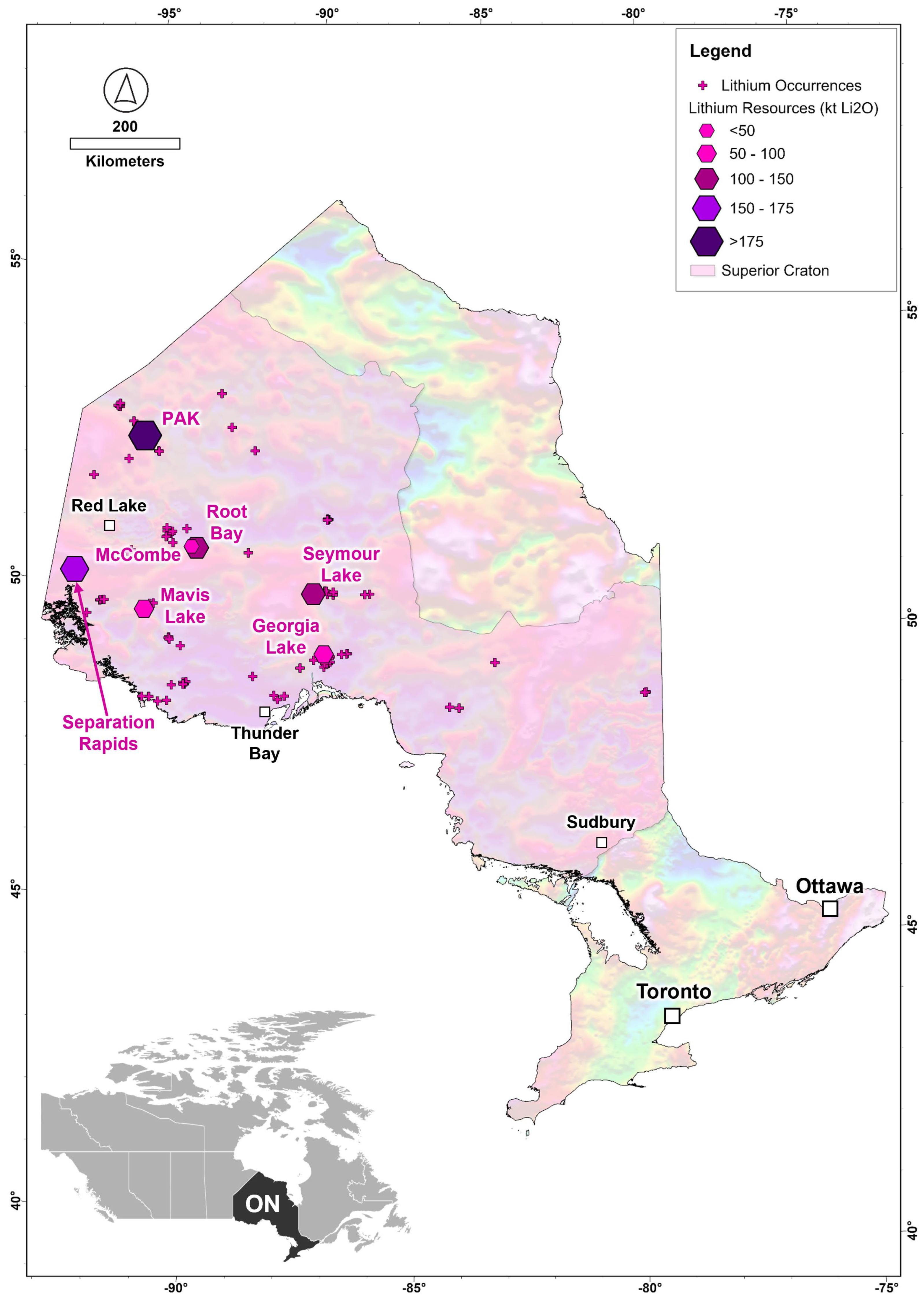
2. Materials and Methods
- A review was undertaken of the LCT pegmatite lithium deposit model with a focus on the deposits of this type in Western Australia and Ontario.
- The supporting spatial input data were compiled and prepared, and the best-performing predictor maps were selected based on the results of spatial statistical assessments.
- A multi-technique approach to mineral potential modeling (MPM) was adopted, using continuous as well as data- and knowledge-driven mathematical techniques, thereby facilitating the cross-validation and comparison of the resulting prospectivity maps.
2.1. Data Sources
2.2. Mineral Occurrence Data
| Data Repository | Datasets and Types | Website URL | |
|---|---|---|---|
| Geological Survey of Western Australia (GSWA) | |||
| Data and Software Center | Mines and mineral deposits (MINEDEX) (GIS point data) 1 Mineral exploration reports (WAMEX) (GIS polygon data) Mineral systems atlas: Rare-element pegmatite systems (GIS point, line, and polygon data) Open-file mineral exploration drillholes (GIS point data) Geochronology (GIS point data) Surface geochemistry (GIS point data) Field observations (WAROX) (GIS point data) Regolith, surface, and interpreted bedrock geology (GIS polygon data) Tectonic units (GIS polygon data) Airborne geophysics (gravity, magnetics, and radiometrics) (GIS raster and/or image data) Multiscale edges from gravity and magnetics (GIS line data) Tenements (GIS polygon data) | [33] | |
| eBookshop | Digital books, reports, and maps (PDF data) | [34] | |
| Ontario Geological Survey (OGS) | |||
| OGSEarth | Mines and mineral deposits (OMI) (GIS point data) 1 Mineral exploration activity reports (OAFD) (GIS polygon data) Open-file mineral exploration drillholes (ODHD) (GIS point data) Geochronology (GIS point data) Surface geochemistry (GIS point data) Surface and interpreted bedrock geology (GIS polygon data) Airborne geophysics (gravity, magnetics) (GIS raster and/or image data) Tenements (GIS polygon data) Digital books, reports, and maps (PDF data) | [35] | |
2.3. Mineral Systems Concept
- Source processes extract the essential mineral deposit components (i.e., melts and/or fluids, metals, and ligands) from their crustal or mantle sources;
- Transport processes drive the transfer of the essential components from source to trap regions via melts and/or fluids;
- Trap processes focus melt and/or fluid flow into physically and/or chemically responsive, deposit-scale sites;
- Deposition processes drive the efficient extraction of metals from melts and/or fluids passing through the traps;
- Preservation processes act to preserve the accumulated metals through time.
2.4. Mineral Potential Modeling (MPM)
- Genetic model stage: Identification of the geological processes that are essential in the formation of the targeted deposit type to build a conceptual deposit model.
- Targeting model stage: Translation of the genetic model into a targeting model in which the essential processes are reflected by mappable targeting criteria (also referred to as targeting elements, predictors, predictor maps, or spatial proxies).
- Mathematical model stage: Allocation of weights to combine the various spatial proxies using mathematical algorithms.
- Target identification and prioritized stage: Mapping and prioritization of the most prospective areas.
3. Lithium–Cesium–Tantalum (LCT) Pegmatites
3.1. Descriptive LCT Pegmatite Deposit Model
3.2. LCT Pegmatites of Western Australia
3.2.1. Geological Background and Distribution of Endowment
3.2.2. LCT Pegmatites of the Archean Yilgarn Craton
3.2.3. LCT Pegmatites of the Archean Pilbara Craton
3.2.4. LCT Pegmatites in Proterozoic Terrain
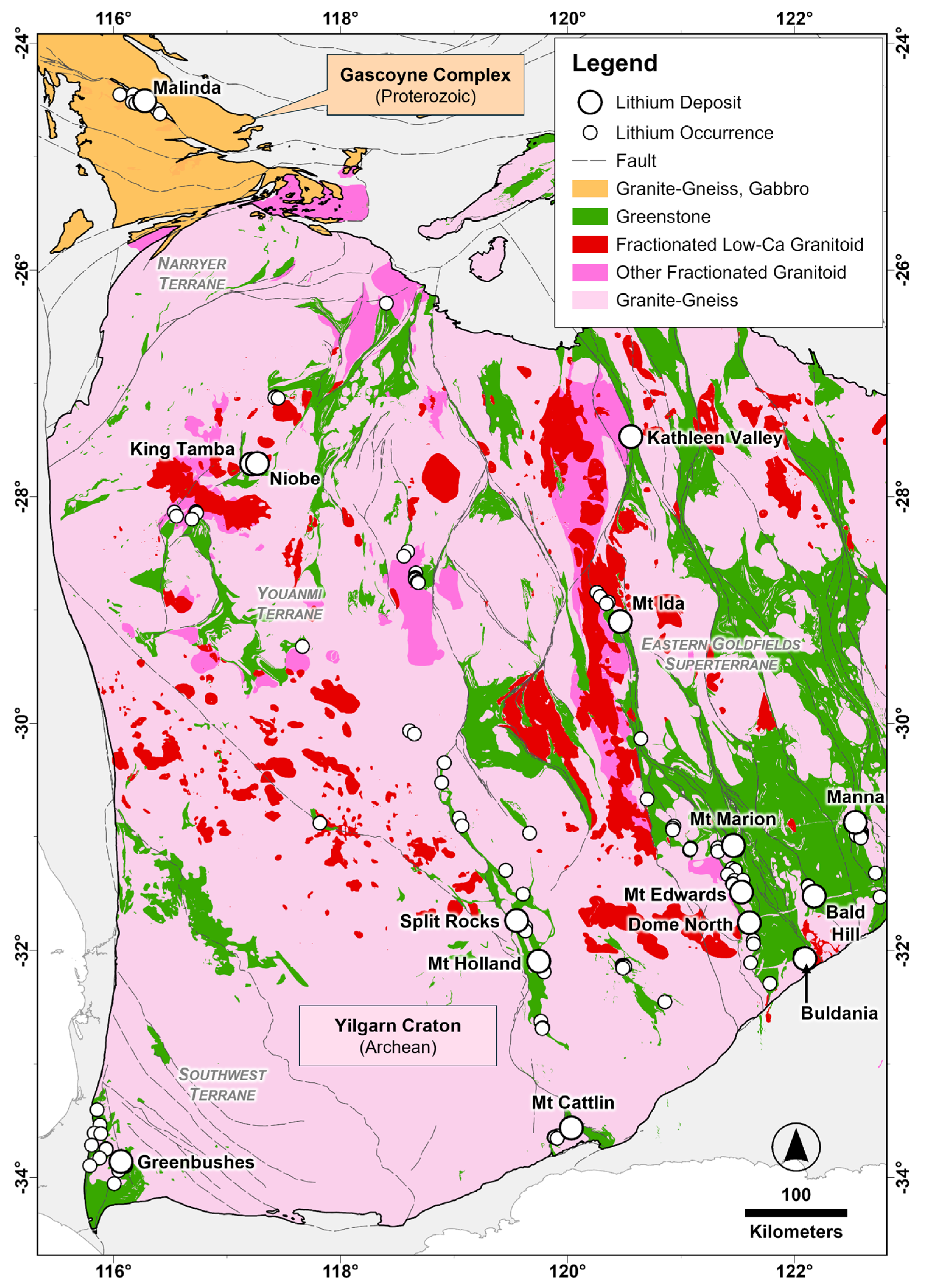
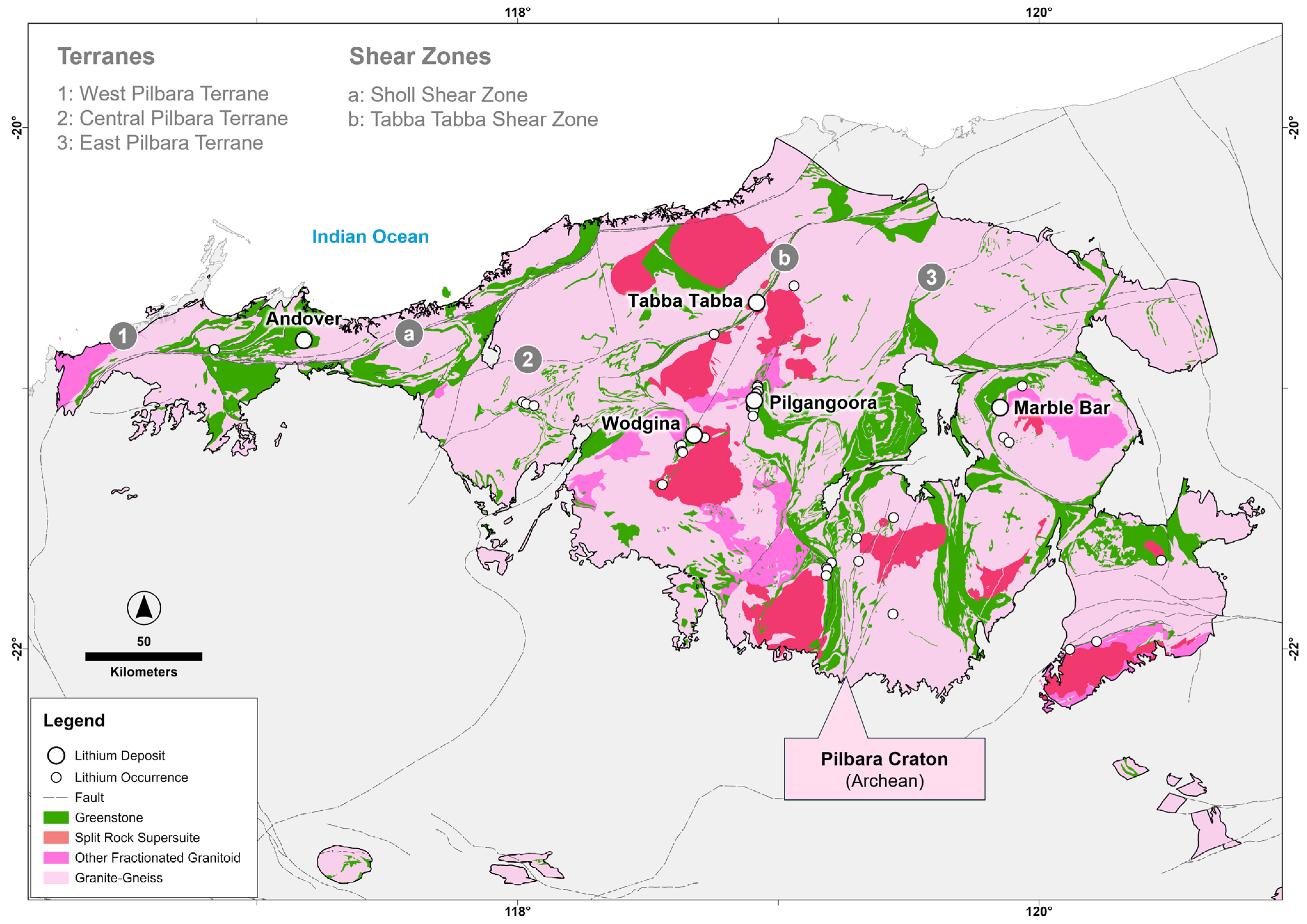
| System | Sub-Type | Province | Age | Geology and Structure | Key Minerals | References |
|---|---|---|---|---|---|---|
| Pilgangoora | LCT-AS | PC | Mesoarchean (~2879 Ma) | HR: basalt, dolerite, undifferentiated ultramafic rock; SC: shear zone corridor; SR: Kadgewarrina and Poocatche Monzogranite, Split Rock Supersuite; MG: upper greenschist to lower amphibolite facies | spd, lpd, cot, cst, tlt, tap, brl | [25,83] |
| Andover | LCT-AS | PC | Mesoarchean | HR: peridotite, dunite; SC: poorly defined and/or described but proximal to shear zone corridor; SR: no obvious causative intrusion; MG: upper greenschist to lower amphibolite facies | spd, lpd, brl, cot, cst | [12] |
| Wodgina | LCT-A + LCT-AS | PC | Mesoarchean (~2829 Ma) | HR: komatiite (Wodgina), metasedimentary sequence (Mt Cassiterite); SC: shear zone corridor; SR: Numbana Monzogranite, Split Rock Supersuite; MG: upper greenschist to lower amphibolite facies | spd, cot, wod, Cs-brl, Li-mic, lit | [25,59] |
| Tabba Tabba | LCT-AS | PC | Mesoarchean (~2877 Ma) | HR: dolerite sill, siliciclastic rocks; SC: shear zone corridor, schistosity; SR: Split Rock Supersuite; MG: upper greenschist to lower amphibolite facies(?) | spd, pet, Li-mic, brl, cot, cst, tlt | [10,84] |
| Marble Bar | LCT-AS (?) | PC | Mesoarchean | HR: amphibolite, dolerite, basalt; SC: shear zone corridor; SR: Moolyella Monzogranite–Mt Edgar Batholith (Split Rock Supersuite); MG: upper greenschist to lower amphibolite facies(?) | spd, cst | [85,86] |
| Greenbushes | LCT-C-spd | YC | Neoarchean (~2527 Ma) | HR: amphibolite, ultramafic schist, granofels; SC: shear zone corridor; SR: no obvious causative intrusion; MG: upper amphibolite facies | spd, brl, cot, cst, wod | [25,62,78,79,80] |
| Mt Holland | LCT-AS | YC | Neoarchean | HR: komatiite, dolerite, basalt, andesite; SC: shear zone corridor, folding; SR: post-tectonic, low-Ca granite; MG: upper greenschist to lower amphibolite facies | spd, pet | [87] |
| Kathleen Valley | LCT-C-spd | YC | Neoarchean | HR: gabbro, basalt, conglomerate; SC: shear zone corridor; SR: post-tectonic, low-Ca granite(?); MG: upper greenschist to lower amphibolite facies | spd, tlt, lpd | [88,89] |
| Mt Marion | LCT-AS + LCT-C-spd | YC | Neoarchean | HR: amphibolite, serpentinite, ultramafic schist, basalt, carbonaceous black shale; SC: folding, shear zone corridor; SR: Depot Granodiorite; MG: lower amphibolite facies | spd, cot, cst, brl, lpd | [90,91] |
| Manna | LCT-AS(?) | YC | Neoarchean | HR: gabbro, basalt; SC: shear zone corridor; SR: Cardunia Granite; MG: lower to middle amphibolite facies(?) | spd, lpd | [92,93] |
| Bald Hill | LCT-AS | YC | Neoarchean | HR: schist, greywacke, granite; SC: schistosity, shear zone corridor; SR: post-tectonic, low-Ca granite(?); MG: upper greenschist to lower amphibolite facies | spd, lpd, tlt | [24] |
| Mt Ida | LCT-AS(?) | YC | Neoarchean | HR: anorthosite-leucogabbro; SC: shear zone corridor, folding; SR: post-tectonic, low-Ca Oberwyl Granite; MG: upper greenschist to lower amphibolite facies | spd, lpd | [94] |
| Mt Cattlin | LCT-AS | YC | Neoarchean (~2625 Ma) | HR: intermediate to mafic volcanic rocks, dolerite, tonalite; SC: shear zone corridor; SR: post-tectonic, fractionated, low-Ca granite; MG: greenschist to amphibolite facies | spd, cot, lpd, tlt, cst, tap, brl | [24,95] |
| Buldania | LCT-C-spd(?) | YC | Neoarchean | HR: komatiite, basalt, dolerite, carbonaceous shale; SC: shear zone corridor; SR: post-tectonic, fractionated, low-Ca granite; MG: upper greenschist to middle amphibolite facies | spd | [96] |
| Dome North | LCT-C-pet | YC | Neoarchean | HR: komatiite, basalt, sedimentary rock sequence; SC: shear zone corridor; SR: Pioneer Monzogranite; MG: upper greenschist to lower amphibolite facies | pol, pet, lpd, spd, lpd | [97] |
| Split Rocks | LCT-C-pet(?) | YC | Neoarchean | HR: undifferentiated mafic rock; SC: shear zone corridor; SR: post-tectonic, fractionated, low-Ca granite(?); MG: lower amphibolite facies(?) | euc, spd, pet, lpd | [98] |
| Mt Edwards | LCT-AS(?) | YC | Neoarchean | HR: komatiite, basalt; SC: shear zone corridor; SR: post-tectonic, fractionated, low-Ca granite(?); MG: middle to upper amphibolite facies | spd | [99] |
| Niobe | LCT-C-lpd(?) | YC | Neoarchean | HR: gabbro; SC: poorly defined and/or described; SR: post-tectonic, fractionated, low-Ca Walganna Suite granite(?); MG: greenschist to amphibolite facies | lpd, zwd, mic, brl, spd(?) | [100] |
| King Tamba | LCT-C-lpd(?) | YC | Neoarchean | HR: dolerite, sedimentary schist; SC: shear zone corridor, folding; SR: post-tectonic, fractionated low-Ca Walganna Suite granite(?); MG: greenschist to amphibolite facies | tap, tlt, cst, lpd, mic, zwd, brl | [101] |
| Malinda | LCT-AS(?) | GO | Neoproterozoic | HR: volcano (mafic)-sedimentary sequence; SC: shear zone corridor, folding; SR: Thirty-Three Supersuite granite; MG: upper greenschist to lower amphibolite facies | spd, lpd, pet, tlt, cst | [82] |
3.3. LCT Pegmatite Systems of Ontario
3.3.1. Geological Background and Distribution of Endowment
3.3.2. LCT Pegmatites of the Archean Superior Craton
- There is good evidence in the Superior Craton of Ontario of a genetic link between fertile parental granites and spatially associated LCT pegmatites. The fertile, peraluminous, Neoarchean-age (2680 to 2640 Ma) S-type granites, derived from the partial melting of a thickened sedimentary crustal source, are most abundant in the metasediment-dominant English River and Quetico terranes. Well-documented examples of lithium source granites and their related pegmatites are the Ghost Lake Batholith and Mavis Lake pegmatites and the Separation Rapids Pluton and Separation Rapids pegmatites, which typically occur no more than 15 km from the margins of their parental intrusions [19,20,108,109]. Terranes that lack these S-type granites are largely devoid of LCT pegmatites (Figure 8).
- Most LCT pegmatites in the Superior Craton of Ontario are classified as complex pegmatites, whereas this subtype is less common in the Archean cratons of Western Australia. Interestingly, the two largest lithium resources in Ontario, hosted by the PAK and Separation Rapids LCT pegmatite systems, both classify as complex petalite types, a category of LCT pegmatite that is rare in Western Australia. On the other hand, Ontario has few known LCT pegmatites of the albite–spodumene type, which is a common type in Western Australia, where pegmatites of this type can host substantial lithium resources.
- As defined from drilling at this time, LCT pegmatites in Ontario have a preponderance for steep to subvertical dip angles (e.g., PAK, Separation Rapids), while their Western Australian counterparts are typically gently dipping to subhorizontal in nature. There also appear to be more examples of LCT pegmatites in Ontario that (i) are tectonically deformed or strongly deformed (e.g., PAK is schistose [110], Separation rapids is complexly folded, strongly schistose, and locally mylonitized [111]), and (ii) have lenticular or prolate (e.g., PAK, Separation Rapids) rather than sheet-like geometries, which is more common in Western Australia. Pegmatite footprints are commonly more modest than in Western Australia, with the larger Ontarian systems (i.e., PAK, Separations Rapids) characterized by strike lengths between 1.5 and 2.3 km, maximum widths between 70 and 125 m, and proven down-dip extents between 275 and 400 m. The smaller systems have strike lengths in the range from 0.2 to 1.3 km, maximum thicknesses from 10 to 25 m, and proven down-dip extents from 300 to 950 m. As in Western Australia, stacked pegmatite systems are commonly observed.
- Ontario’s known LCT pegmatites have a combined lithium resource endowment of 1549 kt Li2O, which amounts to only 6% of the combined Western Australian lithium resource endowment of 25,998 kt Li2O (Table 1). Even at the craton level, the Superior Craton in Ontario hosts significantly less lithium than the Yilgarn (13,916 kt Li2O) or Pilbara (11,839 kt Li2O) cratons of Western Australia, despite its size of ~595,000 km2 (the entire Superior Craton has a size of 1 572 000 km2, comprising almost a quarter of the Earth’s exposed Archean crust [102]), which is comparable to that of the Yilgarn Craton (~609,000 km2) and several times larger than that of the Pilbara Craton (~57,000 km2). Looking at individual deposits, PAK, the largest lithium resource in Ontario, would only rank at number eight amongst the Western Australian lithium resources. To a certain degree, this discrepancy may be a function of exploration maturity, but the latter is unlikely to account for the large variability. Rather, it is more likely that the specific conjunction of critical geological factors, including some of those mentioned above, had an important role to play.
| System | Sub-Type | Province | Age | Geology and Structure | Key Minerals | References |
|---|---|---|---|---|---|---|
| PAK | LCT-C-pet | SC | Neoarchean (~2670 Ma) | HR: felsic to ultramafic volcano-sedimentary rocks, granite; SC: shear zone corridor; SR: peraluminous two-mica granite; MG: amphibolite facies | pet, spd, cot, wod, cst | [25,110,112] |
| Separation Rapids | LCT-C-pet | SC | Neoarchean (~2644 Ma) | HR: basalt (± pillowed); SC: shear zone corridor; SR: Separation Rapids Pluton; MG: lower to middle amphibolite facies | pet, spd, euc, cot, wod, lpd, cst, brl | [25,111] |
| Root Bay | LCT-C-spd | SC | Neoarchean | HR: basalt (± pillowed); SC: shear zone corridor; SR: genetic linkage not well established, possible linkage with Allison Lake Batholith; MG: upper greenschist to lower amphibolite facies(?) | spd | [113] |
| Seymour Lake | LCT-C-spd | SC | Neoarchean (~2666 Ma) | HR: pillow basalt ± amphibolite, dolerite, gabbro; SC: poorly defined and described; SR: no obvious causative intrusion; MG: upper greenschist to lower amphibolite facies(?) | spd, pol, lpd, Cs-brl, cot | [25,113] |
| Georgia Lake | LCT-AS | SC | Neoarchean | HR: sedimentary rocks, granite; SC: poorly defined and described; SR: Glacier Lake and Barbara Lake batholiths; MG: upper greenschist to lower amphibolite facies(?) | spd, brl, cot, cst | [16] |
| Mavis Lake | LCT-AS | SC | Neoarchean (~2665 Ma) | HR: mafic volcanic rock; SC: shear zone corridor; SR: Ghost Lake Batholith; MG: upper greenschist to lower amphibolite facies(?) | spd, tri, cot | [17,25] |
| McCombe | LCT-C-spd | SC | Neoarchean | HR: basalt (± pillowed); SC: shear zone corridor; SR: peraluminous two-mica granite; MG: upper greenschist to lower amphibolite facies(?) | spd, lpd, tlt, col, pet, mic, brl | [113] |
3.4. LCT Pegmatite Targeting Model
4. Mineral Potential Modeling (MPM)
4.1. Statistical Assesment of Spatial Proxies
4.2. Continuous Data-Driven Index Overlay, Continuous Fuzzy Gamma, Geometric Average Approaches
4.2.1. Data-Driven Index Overlay
4.2.2. Continuous Fuzzy Gamma Approach
4.2.3. Geometric Average
4.3. Knowledge-Driven BWM-MARCOS Approach
4.3.1. Western Australian BWM-MARCOS Model
4.3.2. Ontarian BWM-MARCOS Model
4.4. Data-Driven Random Forest (RF) Approach
4.4.1. Western Australian RF Model
4.4.2. Ontarian RF Model
5. Discussion
5.1. Mineral Potential Mapping (MPM)
5.1.1. Criticisms, Limitations, and Opportunities
5.1.2. Spatial Proxy Performance
5.1.3. Comparative Model Performance
5.2. Geological Validity and Insights
5.3. Mineral Exploration Implications
5.3.1. Exploration Search Space Concept
5.3.2. Exploration Maturity and Potential
5.3.3. Western Australian Target Example
6. Summary and Conclusions
- Western Australia has known resources of ~26 Mt Li2O contained in 19 lithium-cesium–tantalum (LCT) pegmatite deposit clusters. One of these clusters is in the Gascoyne Complex and is Proterozoic in age. The remainder is hosted by the Yilgarn and Pilbara cratons and was formed during Archean times. Ontario has a much smaller endowment of ~1.5 Mt Li2O contained in seven LCT pegmatite deposit clusters, all of which are in the Superior Craton and are Archean in age.
- Even the best-endowed lithium pegmatite system in Ontario, PAK, would only rank eighth among the Western Australian lithium pegmatite resources. This size discrepancy may be taken to imply that either the Ontarian LCT pegmatites have lesser endowments than their Western Australian counterparts, or several very substantial pegmatite-hosted lithium resources are yet to be discovered in Ontario or to be fully delineated by further drilling.
- As demonstrated for the Favorable Lake Greenstone Belt of northern Ontario, large tracts of the Archean Superior Craton are significantly underexplored compared to the Archean cratons of Western Australia. Government records indicate that <610 drillholes were completed along the >230 km-long Favorable Lake Greenstone Belt. Despite the presence of the PAK pegmatite cluster, this is one of the largest and highest-grade hardrock lithium resources in North America. In contrast, there are >66,000 publicly recorded drillholes that were completed along the >300 km-long Southern Cross Greenstone Belt, Yilgarn Craton, which hosts one of the world’s largest hard rock lithium deposits at Mount Holland. Large segments, up to 45 km long, of the Favorable Lake Greenstone Belt have never been drilled. No such large undrilled search spaces exist near world-class mineralized systems in the Archean Yilgarn and Pilbara cratons of Western Australia.
- In contrast to the Western Australian LCT pegmatites, the Ontarian systems often illustrate clear genetic links to S-type parental granitoids. Terranes that lack S-type granitoids are typically devoid of LCT pegmatites.
- LCT pegmatites in Ontario commonly have steep to subvertical dip angles and lenticular or prolate geometries (e.g., PAK, Separation Rapids), while their Western Australian counterparts are typically sheet-like and gently dipping to subhorizontal in nature (e.g., Mt Holland, Mt Cattlin, Tabba Tabba).
- Common expressions of LCT pegmatite systems and controls on lithium deposit formation include the following: (i) high degrees of melting of a fertile protolith, typically a sedimentary crustal source (as represented by the S-type, two-mica granitoids of the Superior Craton) or biotite dehydration melting at relatively shallow greenstone-root levels (as potentially represented by the evolved I-type, low-Ca granitoids of the Yilgarn Craton) (in all cases investigated in this study, the crustal melting was spatially associated with convergent margin tectonic settings (Phanerozoic, Proterozoic ± Archean) or continental rift zones marked by greenstone belts (Archean)); (ii) extreme fractionation of the granitic melts that formed the pegmatites; (iii) a high degree of crustal permeability, typically associated with active deformation along first- and second-order fault systems, typically localized along belt margins; and (iv) the presence of mafic to ultramafic rock sequences that have been metamorphosed at greenschist to amphibolite facies grade.
- We adopted a best-practice multi-technique approach to mineral potential mapping (MPM) of the LCT pegmatite system in Western Australia and Ontario, which included the use of five different methods spanning the spectrum between traditional MPM algorithms and artificial intelligence (AI). The best-performing method, the random forest (RF) machine-learning AI technique, achieved excellent overall performance (Op) metrics (Western Australia: Op = 0.52; Ontario: Op = 0.61), bettering all other methods by ~3.05 times for Western Australia and ~2.35 times for Ontario. The validity of the RF model is also demonstrated by most of the known lithium deposits, camps, and districts plotted within areas of elevated to very high lithium favorability, as identified by this modeling approach.
- MPM also identified certain belts that have few to none LCT pegmatite lithium occurrences, but they have moderate to very high lithium potential. In Western Australia, these include, for example, the Proterozoic Halls Creek, southern Capricorn, and Paterson orogens, as well as the eastern Archean Yilgarn Craton. Ontarian examples include the Kasabonika Lake-Ekwan River, Savant Lake-Crow Lake, Stull-Edmound Lake, Swayze, Abitibi, and Michipicoten greenstone belts of the Archean Superior Craton and the pegmatite belts of the Proterozoic Grenville Orogen in southern Ontario. In our opinion, these belts warrant closer investigation as to their LCT pegmatite potential.
- In addition, our modeling revealed a statistically verifiable proximity relationship between lithium, gold, and nickel occurrences. At this stage, the underlying reason for this relationship is speculative, but it seems plausible that the clustering of these different mineral deposit types is linked to their common spatial association with deep-seated faults and mafic–ultramafic rock sequences.
Supplementary Materials
Author Contributions
Funding
Data Availability Statement
Acknowledgments
Conflicts of Interest
References
- Černý, P.; Ercit, T.S. The classification of granitic pegmatites revisited. Can. Mineral. 2005, 43, 2005–2026. [Google Scholar] [CrossRef]
- Bradley, D.C.; Stillings, L.L.; Jaskula, B.W.; Munk, L.; McCauley, A.D. Lithium. In Critical Mineral Resources of the United States—Economic and Environmental Geology and Prospects for Future Supply; Professional Paper 1802; Schulz, K.J., DeYoung, J.H., Jr., Seal, R.R., II, Bradley, D.C., Eds.; U.S. Geological Survey: Reston, VA, USA, 2017; pp. K1–K21. [Google Scholar]
- Bradley, D.C.; McCauley, A.D.; Stillings, L.M. Mineral-deposit model for lithium-cesium-tantalum pegmatites. In Mineral Deposit Models for Resource Assessment; Scientific Investigations Report 2010–5070–O; U.S. Geological Survey: Reston, VA, USA, 2017; pp. 1–48. [Google Scholar]
- Bradley, D.C. Tectonic and paleoclimatic controls of lithium-cesium-tantalum (LCT) pegmatite genesis, exhumation, and preservation in the Appalachians. Can. Mineral. 2019, 57, 715–717. [Google Scholar] [CrossRef]
- RCF Ambrian. Lithium Commodity Market Report, August 2023; RCF Ambrian: London, UK, 2023; 53p. [Google Scholar]
- Geological Survey of Western Australia. Lithium Investment Opportunities, December 2023; Government of Western Australia, Department of Energy, Mines, Industry Regulation and Safety: Perth, Australia, 2023; 2p.
- Hard Rock Lithium Deposits. Available online: https://www.geologyforinvestors.com/hard-rock-lithium-deposits/ (accessed on 14 December 2024).
- Critical Minerals Analysis, Ontario Mining Association. 2022. Available online: https://oma.on.ca/en/ontario-mining/2022_OMA_Mineral_Profiles.pdf (accessed on 14 December 2024).
- Ontario Geological Survey. An Introduction to Ontario’s Critical Minerals, with Highlights from the Ontario Mineral Inventory; Ministry of Northern Development, Mines, Natural Resources and Forestry: Sudbury, ON, Canada, 2022; 69p.
- Wildcat Resources Limited. Wildcat Delivers Australia’s Largest Undeveloped Lithium Resource of 74 Mt @ 1.0% Li2O at Tabba Tabba, WA. In Australian Securities Exchange (ASX) Announcement Dated 18 November 2024; Wildcat Resources Limited: Perth, WA, Australia, 2024; 42p. [Google Scholar]
- Global Lithium Resources Limited. GL1 Delivers Transformative 50.7 Mt Lithium Resource Base. In Australian Securities Exchange (ASX) Announcement Dated 15 December 2022; Global Lithium Resources Limited: Perth, WA, Australia, 2022; 37p. [Google Scholar]
- Azure Minerals Limited. Exploration Target–Andover Lithium Project. In Australian Securities Exchange (ASX) Announcement Dated 7 August 2023; Azure Minerals Limited: Perth, WA, Australia, 2023; 19p. [Google Scholar]
- Frontier Lithium Inc. Corporate Presentation, 25 November 2024, 20p. Available online: https://www.frontierlithium.com/investors-1/ (accessed on 11 December 2024).
- Avalon Advanced Materials Inc. Avalon announces a substantive 20% increase in deposit size at its flagship Separation Rapids joint-venture lithium project. In Toronto Securities Exchange (TSX) Announcement Dated 10 August 2023; Avalon Advanced Materials Inc.: Toronto, ON, Canada, 2023; 7p. [Google Scholar]
- Green Technology Metals Limited. Significant resource and confidence level increase at Root, global resource inventory now at 24.5 Mt. In Australian Securities Exchange (ASX) Announcement Dated 17 October 2023; Green Technology Metals Limited: Subiaco, WA, Australia, 2023; 89p. [Google Scholar]
- AMC Mining Consultants (Canada) Limited. Technical Report, Georgia Lake Lithium Project Pre-Feasibility Study; RockTech Lithium Inc.: Vancouver, BC, Canada, 2022; 350p. [Google Scholar]
- Critical Resources Limited. 8.0 Mt at 1.07% Li2O maiden mineral resource at Mavis Lake. In Australian Securities Exchange (ASX) Announcement Dated 5 May 2023; Critical Resources Limited: Perth, WA, Australia, 2023; 25p. [Google Scholar]
- Sweetapple, M.T.; Collins, P.L. Genetic framework for the classification and distribution of Archean rare metal pegmatites in the north Pilbara Craton, Western Australia. Econ. Geol. 2002, 97, 873–895. [Google Scholar] [CrossRef]
- Breaks, F.W.; Selway, J.B.; Tindle, A.G. Fertile peraluminous granites and related rare-element mineralization in pegmatites, Superior Province, northwest and northeast Ontario: Operation treasure hunt. Ont. Geol. Surv. Open File Rep. 2003, 6099, 179. [Google Scholar]
- Selway, J.B.; Breaks, F.W.; Tindle, A.G. A review of rare-element (Li-Cs-Ta) pegmatite exploration techniques for the Superior Province, Canada, and large worldwide tantalum deposits. Explor. Min. Geol. 2005, 14, 1–30. [Google Scholar] [CrossRef]
- Sweetapple, M.T. A review of the setting and internal characteristics of lithium pegmatite systems of the Archaean north Pilbara and Yilgarn cratons, Western Australia. In Proceedings of the Extended Abstracts (Australian Institute of Geoscientists Bulletin, 65, 113–117), Granites 2017 Conference, Benalla, VIC, Australia, 25–28 September 2017. [Google Scholar]
- Duuring, P. Rare-element pegmatites: A mineral systems analysis. In Geological Survey of Western Australia Record 2020/7; Geological Survey of Western Australia: East Perth, Australia, 2020; 6p. [Google Scholar]
- Phelps-Barber, Z.; Trench, A.; Groves, D.I. Recent pegmatite-hosted spodumene discoveries in Western Australia: Insights for lithium exploration in Australia and globally. Appl. Earth Sci. 2022, 131, 100–113. [Google Scholar] [CrossRef]
- Wells, M.; Aylmore, M.; McInnes, B. MRIWA Report M532—The geology, mineralogy and geometallurgy of EV materials deposits in Western Australia. Geol. Surv. West. Aust. Rep. 2022, 228, 187. [Google Scholar]
- Sweetapple, M.T.; Vanstone, P.J.; Lumpkin, G.R.; Collins, P.L.F. A review of lithogeochemical dispersion haloes of LCT pegmatites, and their application to rare metal exploration, with special reference to lithium in an Australian context. Aust. J. Earth Sci. 2024, 71, 1050–1084. [Google Scholar] [CrossRef]
- Data WA. Available online: https://www.data.wa.gov.au/ (accessed on 4 March 2025).
- GeologyOntario. Available online: https://www.hub.geologyontario.mines.gov.on.ca/ (accessed on 4 March 2025).
- Bruce, M.; Kreuzer, O.P.; Wilde, A.; Buckingham, A.; Butera, K.; Bierlein, F. Unconformity-type uranium systems: A comparative review and predictive modelling of critical genetic factors. Minerals 2020, 10, 738. [Google Scholar] [CrossRef]
- Roshanravan, B.; Kreuzer, O.P.; Buckingham, A.; Keykhay-Hosseinpoor, M.; Keys, E. Mineral potential modelling of orogenic gold systems in the Granites-Tanami Orogen, Northern Territory, Australia: A multi-technique approach. Ore Geol. Rev. 2023, 152, 105224. [Google Scholar] [CrossRef]
- Wyborn, L.A.I.; Heinrich, C.A.; Jaques, A.L. Australian Proterozoic mineral systems: Essential ingredients and mappable criteria. In Proceedings of the 1994 AusIMM Annual Conference: Australian Mining Looks North—The Challenges and Choices, Darwin, NT, Australia, 5–9 August 1994; pp. 109–115. [Google Scholar]
- Knox-Robinson, C.M.; Wyborn, L.A.I. Towards a holistic exploration strategy: Using geographic information systems as a tool to enhance exploration. Aust. J. Earth Sci. 1997, 44, 453–463. [Google Scholar] [CrossRef]
- McCuaig, T.C.; Beresford, S.; Hronsky, J. Translating the mineral systems approach into an effective exploration targeting system. Ore Geol. Rev. 2010, 38, 128–138. [Google Scholar] [CrossRef]
- Welcome to DEMIRS Data and Software Centre. Available online: https://dasc.dmirs.wa.gov.au/ (accessed on 4 March 2025).
- eBookshop. Available online: https://dmpbookshop.eruditetechnologies.com.au/ (accessed on 4 March 2025).
- OGSEarth. Available online: https://www.geologyontario.mndm.gov.on.ca/ogsearth.html (accessed on 4 March 2025).
- McCuaig, T.C.; Hronsky, J.M.A. The mineral system concept—The key to exploration targeting. Soc. Econ. Geol. Spec. Publ. 2014, 18, 153–175. [Google Scholar] [CrossRef]
- Hagemann, S.G.; Lisitsin, V.A.; Huston, D.L. Mineral system analysis: Quo vadis. Ore Geol. Rev. 2016, 76, 504–522. [Google Scholar] [CrossRef]
- Kreuzer, O.P.; Etheridge, M.A.; Guj, P.; McMahon, M.E.; Holden, D.J. Linking mineral deposit models to quantitative risk analysis and decision-making in exploration. Econ. Geol. 2008, 103, 829–850. [Google Scholar] [CrossRef]
- Kreuzer, O.P.; Miller, A.V.; Peters, K.J.; Payne, C.; Wildman, C.; Partington, G.A.; Puccioni, E.; McMahon, M.E.; Etheridge, M.A. Comparing prospectivity modelling results and past exploration data: A case study of porphyry Cu–Au mineral systems in the Macquarie Arc, Lachlan Fold Belt, New South Wales. Ore Geol. Rev. 2015, 71, 516–544. [Google Scholar] [CrossRef]
- Kreuzer, O.P.; Buckingham, A.; Mortimer, J.; Walker, G.; Wilde, A.; Appiah, K. An integrated approach to the search for gold in a mature, data-rich brownfields environment: A case study from Sigma-Lamaque, Quebec. Ore Geol. Rev. 2019, 111, 102977. [Google Scholar] [CrossRef]
- Roshanravan, B.; Kreuzer, O.P.; Bruce, M.; Davis, J.; Briggs, M. Modelling gold potential in the Granites-Tanami Orogen, NT, Australia: A comparative study using continuous and data-driven techniques. Ore Geol. Rev. 2020, 125, 103661. [Google Scholar] [CrossRef]
- Kreuzer, O.P.; Yousefi, M.; Nykänen, V. Introduction to the special issue on spatial modelling and analysis of ore-forming processes in mineral exploration targeting. Ore Geol. Rev. 2020, 119, 103391. [Google Scholar] [CrossRef]
- Agterberg, F.P. Computer programs for mineral exploration. Science 1989, 245, 76–81. [Google Scholar] [CrossRef]
- Bonham-Carter, G.F.; Agterberg, F.P.; Wright, D.F. Integration of geological datasets for gold exploration in Nova Scotia. Digit. Geol. Geogr. Inf. Syst. 1989, 10, 15–23. [Google Scholar]
- Carranza, E.J.M. Geochemical Anomaly and Mineral Prospectivity Mapping in GIS—Handbook of Exploration and Environmental Geochemistry 11; Elsevier: Amsterdam, The Netherlands, 2008; 351p. [Google Scholar]
- Joly, A.; Porwal, A.K.; McCuaig, T.C. Exploration targeting for orogenic gold deposits in the Granites-Tanami Orogen: Mineral system analysis, targeting model and prospectivity analysis. Ore Geol. Rev. 2012, 48, 349–383. [Google Scholar] [CrossRef]
- Porwal, A.K.; Carranza, E.J.M. Introduction to the special issue: GIS-based mineral potential modelling and geological data analyses for mineral exploration. Ore Geol. Rev. 2015, 71, 477–483. [Google Scholar] [CrossRef]
- Roshanravan, B.; Kreuzer, O.P.; Buckingham, A. BWM-MARCOS: A new hybrid MCDM approach for mineral potential modelling. J. Geochem. Explor. 2025, 269, 107639. [Google Scholar] [CrossRef]
- Bonham-Carter, G.F. Geographic Information Systems for Geoscientists: Modelling with GIS; Pergamon: Oxford, UK, 1994; 416p. [Google Scholar]
- Yousefi, M.; Nykänen, V. Data-driven logistic-based weighting of geochemical and geological evidence layers in mineral prospectivity mapping. J. Geochem. Explor. 2016, 164, 94–106. [Google Scholar] [CrossRef]
- Yousefi, M.; Carranza, E.J.M. Data-driven index overlay and Boolean logic mineral prospectivity modeling in greenfields exploration. Nat. Resour. Res. 2016, 25, 3–18. [Google Scholar] [CrossRef]
- Yousefi, M.; Carranza, E.J.M. Fuzzification of continuous-value spatial evidence for mineral prospectivity mapping. Comput. Geosci. 2015, 74, 97–109. [Google Scholar] [CrossRef]
- Yousefi, M.; Carranza, E.J.M. Geometric average of spatial evidence data layers: A GIS-based multi-criteria decision-making approach to mineral prospectivity mapping. Comput. Geosci. 2015, 83, 72–79. [Google Scholar] [CrossRef]
- Breiman, L. Random forests. Mach. Learn. 2001, 45, 5–32. [Google Scholar] [CrossRef]
- London, D. Rare-element granitic pegmatites. Rev. Econ. Geol. 2016, 18, 165–193. [Google Scholar]
- London, D. Ore-forming processes within granitic pegmatites. Ore Geol. Rev. 2018, 101, 349–383. [Google Scholar] [CrossRef]
- Steiner, B.M. Tools and workflows for grassroots Li-Cs-Ta (LCT) pegmatite exploration. Minerals 2019, 9, 499. [Google Scholar] [CrossRef]
- Černý, P.; London, D.; Novák, M. Granitic pegmatites as reflections of their sources. Elements 2012, 8, 289–294. [Google Scholar] [CrossRef]
- Dittrich, T.; Seifert, T.; Schulz, B.; Hagemann, S.; Gerdes, A.; Pfänder, J. Archean Rare-Metal Pegmatites in Zimbabwe and Western Australia; Springer: Cham, Switzerland, 2019; 125p. [Google Scholar]
- Nebel, O.; Vandenburg, E.D.; Capitanio, F.A.; Smithies, R.H.; Mulder, J.; Cawood, P.A. Early Earth “subduction”: Short-lived, off-craton, shuffle tectonics, and no plate boundaries. Precambrian Res. 2024, 408, 107431. [Google Scholar] [CrossRef]
- Smithies, R.H.; Gessner, K.; Lu, Y.; Kirkland, C.L.; Ivanic, T.; Lowrey, J.R.; Champion, D.C.; Sapkota, J.; Masurel, Q.; Thébaud, N.; et al. Geochemical mapping of lithospheric architecture disproves Archean terrane accretion in the Yilgarn craton. Geology 2024, 52, 141–146. [Google Scholar] [CrossRef]
- Behre Dolbear Australia Pty Limited. Competent Persons Report, Greenbushes Lithium Mine–Western Australia, Australia, and Cuola Lithium Project–Sichuan, People’s Republic of China; Tianqi Lithium Corporation: North Sydney, NSW, Australia, 2022; 195p. [Google Scholar]
- London, D. The origin of primary textures in granitic pegmatites. Can. Mineral. 2009, 47, 697–724. [Google Scholar] [CrossRef]
- Blewett, R.S.; Kennett, B.L.N.; Huston, D.L. Australia in time and space. In Shaping a Nation: A Geology of Australia; Blewett, R.S., Ed.; Geoscience Australia and Australian National University (ANU) E Press: Canberra, Australia, 2012; pp. 47–119. [Google Scholar]
- Cawood, P.A.; Korsch, R.J. Assembling Australia: Proterozoic building of a continent. Precambrian Res. 2008, 166, 1–35. [Google Scholar] [CrossRef]
- Huston, D.L.; Blewett, R.S.; Champion, D.C. Australia through time: A summary of its tectonic and metallogenic evolution. Episodes 2012, 35, 23–43. [Google Scholar] [CrossRef]
- Johnson, S.P. The Birth of Supercontinents and the Proterozoic Assembly of Western Australia; Geological Survey of Western Australia: Perth, Australia, 2013; 78p.
- Aitken, A.R.A.; Occhipinti, S.A.; Lindsay, M.D.; Joly, A.; Howard, H.M.; Johnson, S.P.; Hollis, J.A.; Spaggiari, C.V.; Tyler, I.M.; McCuaig, T.C.; et al. The tectonics and mineral systems of Proterozoic Western Australia: Relationships with supercontinents and global secular change. Geosci. Front. 2018, 9, 295–316. [Google Scholar] [CrossRef]
- Sweetapple, M.T. Granitic pegmatites as mineral systems: Examples from the Archaean. In Proceedings of the PEG2017—8th International Symposium on Granitic Pegmatites, NGF Abstracts and Proceedings of the Geological Society of Norway, Kristiansand, Norway, 13–15 June 2017; pp. 139–142. [Google Scholar]
- GSWA Open Day 2024|A Li-Pegmatite Paradigm Consistent with Western Australia’s Archean Geology. Available online: https://www.youtube.com/watch?v=9pqPLwDUYQA (accessed on 17 January 2025).
- Champion, D.C.; Sheraton, J.W. Geochemistry and Nd isotope systematics of Archaean granites of the Eastern Goldfields, Yilgarn Craton, Australia: Implications for crustal growth processes. Precambrian Res. 1997, 83, 109–132. [Google Scholar] [CrossRef]
- Kendall-Langley, L.; Kemp, A.I.S.; Grigson, J.L.; Hammerli, J. U-Pb and reconnaissance Lu-Hf isotope analysis of cassiterite and columbite group minerals from Archean Li-Cs-Ta type pegmatites of Western Australia. Lithos 2020, 352, 105231. [Google Scholar] [CrossRef]
- Champion, D.C.; Cassidy, K.F. An overview of the Yilgarn craton and its crustal evolution. In Proceedings of the Geoconferences (WA) Inc. Kalgoorlie ‘07 Conference, Kalgoorlie, Australia, 25–27 September 2007; Geoscience Australia Record 2007/14. pp. 8–13. [Google Scholar]
- Cassidy, K.F.; Champion, D.C.; McNaughton, N.; Fletcher, I.; Whitaker, A.; Bastrakova, I.; Budd, A. Characterisation and Metallogenic Significance of Archean Granitoids of the Yilgarn Craton, Western Australia; Minerals and Energy Research Institute of Western Australia (MERIWA): Perth, Australia, 2002; Report 222; 536p.
- Witt, W.K. Heavy-Mineral Characteristics, Structural Setting, and Parental Granites of Pegmatites in Archean Rocks of the Eastern Yilgarn Craton; Record 1992/10; Geological Survey of Western Australia: Perth, Australia, 1992; 61p.
- Korhonen, F.J.; Kelsey, D.E.; Ivanic, T.J.; Blereau, E.R.; Smithies, R.H.; De Paoli, M.C.; Fielding, I.O. Radiogenic heat production provides a thermal threshold for Archean cratonization process. Geology 2024, 53, 222–226. [Google Scholar] [CrossRef]
- Partington, G.A. Greenbushes tin, tantalum and lithium deposit. In Australian Ore Deposits; Monograph 32; Phillips, N., Ed.; The Australasian Institute of Mining and Metallurgy: Carlton, VIC, Australia, 2017; pp. 153–157. [Google Scholar]
- Bettenay, L.F.; Partington, G.A.; Groves, D.I. Development of Exploration Criteria for Sn-Ta Pegmatites: Use of Host Rock Association and Alteration Haloes; Report 13; Western Australian Mining & Petroleum Research Institute (WAMPRI): Perth, Australia, 1985; 56p.
- Partington, G.A. Environment and structural controls on the intrusion of the giant rare metal Greenbushes pegmatite, Western Australia. Econ. Geol. 1990, 85, 437–456. [Google Scholar] [CrossRef]
- Partington, G.A.; McNaughton, N.J.; Williams, I.S. A review of the geology, mineralization, and geochronology of the Greenbushes pegmatite, Western Australia. Econ. Geol. 1995, 90, 616–635. [Google Scholar] [CrossRef]
- Sheppard, S.; Johnson, S.P.; Wingate, M.T.D.; Kirkland, C.L.; Pirajno, F. Explanatory Notes for the Gascoyne Province; Geological Survey of Western Australia: Perth, Australia, 2010; 336p.
- Delta Lithium Limited. Yinnetharra lithium project maiden mineral resource estimate. In Australian Securities Exchange (ASX) Announcement Dated 27 December 2023; Delta Lithium Limited: West Perth, WA, Australia, 2023; 28p. [Google Scholar]
- Holmes, J. Discovery and Geology of the Pilgangoora Li-Ta Pegmatite Deposit, Western Australia; Centre for Exploration Targeting (CET) Members Day: Perth, Australia, 2022. [Google Scholar]
- Tabba Tabba Pegmatite (Tabba Tabba Tantalum Mine), East Pilbara Shire, Western Australia, Australia. Available online: https://www.mindat.org/loc-12495.html/ (accessed on 10 January 2025).
- Global Lithium Resources Limited. Prospectus. In Australian Securities Exchange (ASX) Announcement Dated 4 May 2021; Global Lithium Resources Limited: Perth, WA, Australia, 2021; 198p. [Google Scholar]
- Blockley, J.G. The tin deposits of Western Australia, with special reference to the associated granites. In Geological Survey of Western Australia Mineral Resources Bulletin; Geological Survey of Western Australia: East Perth, Australia; Volume 12, 184p.
- Sociedad Química y Minera de Chile. Technical Report Summary, Mt Holland Lithium Project; Sociedad Química y Minera de Chile: Santiago, Chile, 2022; 115p. [Google Scholar]
- Kathleen Valley—Kathleens Corner, Mount Mann. Available online: https://portergeo.com.au/database/mineinfo.asp?mineid=mn1781 (accessed on 10 January 2025).
- Liontown Resources Limited. Kathleen Valley confirmed as a world-class lithium deposit as mineral resource increases to 156Mt @ 1.4% Li2O. In Australian Securities Exchange (ASX) Announcement Dated 11 May 2020; Liontown Resources Limited: West Perth, WA, Australia, 2020; 25p. [Google Scholar]
- Ross, J.R.; Smith, B. Mount Marion lithium pegmatite deposit. In Australian Ore Deposits; Monograph 32; Phillips, N., Ed.; The Australasian Institute of Mining and Metallurgy: Carlton, VIC, Australia, 2017; pp. 161–162. [Google Scholar]
- Mount Marion. Available online: https://portergeo.com.au/database/mineinfo.asp?mineid=mn1543 (accessed on 10 January 2025).
- Global Lithium Resources Limited. 9.9 million tonnes @ 1.14% Li2O and 49 ppm Ta2O5, maiden Manna project lithium resource. In Australian Securities Exchange (ASX) Announcement Dated 17 February 2022; Global Lithium Resources Limited: Perth, WA, Australia, 2022; 17p. [Google Scholar]
- Global Lithium Resources Limited. Manna ore sorting trial confirms excellent results across range of ore grades. In Australian Securities Exchange (ASX) Announcement Dated 4 July 2024; Global Lithium Resources Limited: Perth, WA, Australia, 2024; 24p. [Google Scholar]
- Delta Lithium Limited. Mt Ida lithium project mineral resource estimate upgrade. In Australian Securities Exchange (ASX) Announcement Dated 3 October 2023; Delta Lithium Limited: West Perth, WA, Australia, 2023; 23p. [Google Scholar]
- Mining Plus Pty. Limited. SEC Technical Report Summary, Mt. Cattlin Lithium Project; Allkem Limited: Brisbane, Australia, 2023; 310p. [Google Scholar]
- Liontown Resources Limited. Liontown announces maiden mineral resource estimate for its 100%-owned Buldania lithium project, WA. In Australian Securities Exchange (ASX) Announcement Dated 8 November 2019; Liontown Resources Limited: West Perth, WA, Australia, 2019; 16p. [Google Scholar]
- Develop Global Limited. Updated scoping study shows Pioneer Dome set to generate strong free cashflow. In Australian Securities Exchange (ASX) Announcement Dated 7 May 2024; Develop Global Limited: West Leederville, WA, Australia, 2024; 38p. [Google Scholar]
- Zenith Minerals Limited. Maiden lithium minerals resource. In Australian Securities Exchange (ASX) Announcement Dated 28 September 2023; Zenith Minerals Limited: West Perth, WA, Australia, 2023; 34p. [Google Scholar]
- Widgie Nickel Limited. 375% growth in Faraday-Trainline lithium mineral resource. In Australian Securities Exchange (ASX) Announcement Dated 8 November 2024; Widgie Nickel Limited: Perth, WA, Australia, 2024; 34p. [Google Scholar]
- Mount Farmer Mine (Niobe Prospect), Yalgoo Shire, Western Australia, Australia. Available online: https://www.mindat.org/loc-248995.html (accessed on 10 January 2025).
- King Tamba Specialty Metals Project. Available online: https://www.ktaresources.com/king-tamba-speciality-metals-project/ (accessed on 10 January 2025).
- Thurston, P.C. Archean geology of Ontario: Introduction. In Geology of Ontario; Thurston, P.C., Williams, H.R., Sutcliffe, R.H., Stott, G.M., Eds.; Ontario Geological Survey, Ministry of Northern Development and Mines: Toronto, ON, Canada, 1991; Volume 4 Pt 1, pp. 73–78. [Google Scholar]
- Percival, J.A.; Sanborn-Barrie, M.; Skulski, T.; Stott, G.M.; Helmstaedt, H.; White, D.J. Tectonic evolution of the western Superior Province from NATMAP and Lithoprobe studies. Can. J. Earth Sci. 2006, 43, 1085–1117. [Google Scholar] [CrossRef]
- Percival, J.A. Geology and metallogeny of the Superior Province, Canada. In Mineral Deposits of Canada: A Synthesis of Major Deposit-Types, District Metallogeny, the Evolution of Geological Provinces, and Exploration Methods; Goodfellow, W.D., Ed.; Geological Association of Canada, Mineral Deposits Division: St. John’s, NL, Canada, 2007; Volume 5, pp. 903–928. [Google Scholar]
- Bjorkman, K.E. 4D Crust-Mantle Evolution of the Western Superior Craton: Implications for Archaean Granite-Greenstone Petrogenesis and Geodynamics. Ph.D. Thesis, The University of Western Australia, Perth, Australia, 2017; 313p. [Google Scholar]
- Fyon, J.A.; Bennett, G.; Jackson, S.L.; Garland, M.I.; Easton, R.M. Metallogeny of the Proterozoic eon, northern Great Lakes region, Ontario. In Geology of Ontario; Thurston, P.C., Williams, H.R., Sutcliffe, R.H., Stott, G.M., Eds.; Ontario Geological Survey, Ministry of Northern Development and Mines: Toronto, ON, Canada, 1991; Volume 4 Pt 2, pp. 1177–1215. [Google Scholar]
- Easton, R.M.; Fyon, J.A. Metallogeny of the Grenville Province. In Geology of Ontario; Thurston, P.C., Williams, H.R., Sutcliffe, R.H., Stott, G.M., Eds.; Ontario Geological Survey, Ministry of Northern Development and Mines: Toronto, ON, Canada, 1991; Volume 4 Pt 2, pp. 1217–1252. [Google Scholar]
- Larbi, Y.; Stevenson, R.; Breaks, F.; Machado, N.; Gariépy, C. Age and isotopic composition of late Archean leucogranites: Implications for continental collision in the western Superior Province. Can. J. Earth Sci. 1999, 36, 495–510. [Google Scholar] [CrossRef]
- Baker, D.R. The escape of pegmatite dikes from granitic plutons; constraints from new models of viscosity and dike propagation. Can. Mineral. 1998, 36, 255–263. [Google Scholar]
- BBA E&C Inc. NI 43-101 Technical Report, Pre-Feasibility Study for the PAK Project; Frontier Lithium Inc.: Sudbury, ON, Canada, 2023; 657p. [Google Scholar]
- Micon International Limited. NI 43-101 Technical Report on the Preliminary Economic Assessment of Lithium Hydroxide Production, Separation Rapids Lithium Project, Kenora, Ontario; Avalon Advanced Materials Inc.: Toronto, ON, Canada, 2016; 262p. [Google Scholar]
- Frontier Lithium Inc. Frontier Lithium announces expansion of Spark deposit—18.8 Mt in indicated and 29.7 Mt in inferred categories. In TSX Venture Exchange (TSXV) Announcement Dated 28 February 2023; Frontier Lithium Inc.: Sudbury, ON, Canada, 2023; 3p. [Google Scholar]
- Green Technology Metals Limited. Prospectus. In Australian Securities Exchange (ASX) Announcement Dated 8 November 2021; Green Technology Metals Limited: West Perth, WA, Australia, 2021; 305p. [Google Scholar]
- Hronsky, J.M.; Kreuzer, O.P. Applying spatial prospectivity mapping to exploration targeting: Fundamental practical issues and suggested solutions for the future. Ore Geol. Rev. 2019, 107, 647–653. [Google Scholar] [CrossRef]
- Lachaud, A.; Marcus, A.; Vučetić, S.; Mišković, I. Study of the influence of non-deposit locations in data-driven mineral prospectivity mapping: A case study on the Iskut project in northwestern British Columbia, Canada. Minerals 2021, 11, 597. [Google Scholar] [CrossRef]
- Nykänen, V.; Lahti, I.; Niiranen, T.; Korhonen, K. Receiver operating characteristics (ROC) as validation tool for prospectivity models—A magmatic Ni-Cu case study from the central Lapland greenstone belt, northern Finland. Ore Geol. Rev. 2015, 71, 853–860. [Google Scholar] [CrossRef]
- Roshanravan, B.; Agajani, H.; Yousefi, M.; Kreuzer, O.P. Generation of a geochemical model to prospect podiform chromite deposits in North of Iran. In Proceedings of the Generation of a Geochemical Model to Prospect Podiform Chromite Deposits in North of Iran, 80th EAGE Conference and Exhibition, Copenhagen, Denmark, 11–14 June 2018. [Google Scholar]
- Roshanravan, B.; Kreuzer, O.P.; Buckingham, A.; Keys, E. On data quality in mineral potential modelling: A case study using random forest and fractal techniques. In Proceedings of the 84th EAGE Annual Conference & Exhibition, Vienna, Austria, 5–8 June 2023. [Google Scholar]
- Mihalasky, M.J.; Bonham-Carter, G.F. Lithodiversity and its spatial association with metallic mineral sites, Great Basin of Nevada. Nat. Resour. Res. 2001, 10, 209–226. [Google Scholar] [CrossRef]
- Tsoukalas, L.H.; Uhrig, R.E. Fuzzy and Neural Approaches in Engineering; John Wiley & Sons: New York, NY, USA, 1997; 606p. [Google Scholar]
- Nykänen, V.; Groves, D.I.; Ojala, V.J.; Eilu, P.; Gardoll, S.J. Reconnaissance-scale conceptual fuzzy-logic prospectivity modelling for iron oxide copper-gold deposits in the northern Fennoscandian Shield, Finland. Aust. J. Earth Sci. 2008, 55, 25–38. [Google Scholar] [CrossRef]
- Karbalaei-Ramezanali, A.; Feizi, F.; Jafarirad, A.; Lotfi, M. Application of best-worst method and additive ratio assessment in mineral prospectivity mapping: A case study of vein-type copper mineralization in the Kuhsiah-e-Urmak Area, Iran. Ore Geol. Rev. 2020, 117, 103268. [Google Scholar] [CrossRef]
- Feizi, F.; Karbalaei-Ramezanali, A.A.; Farhadi, S. FUCOM-MOORA and FUCOM-MOOSRA: New MCDM-based knowledge-driven procedures for mineral potential mapping in greenfields. SN Appl. Sci. 2021, 3, 358. [Google Scholar] [CrossRef]
- Aryafar, A.; Roshanravan, B. BWM-SAW: A new hybrid MCDM technique for modeling of chromite potential in the Birjand district, east of Iran. J. Geochem. Explor. 2021, 231, 106876. [Google Scholar] [CrossRef]
- Riahi, S.; Fathianpour, N.; Tabatabaei, S.H. Improving the accuracy of detecting and ranking favorable porphyry copper prospects in the east of Sarcheshmeh copper mine region using a two-step sequential Fuzzy-Fuzzy TOPSIS integration approach. J. Asian Earth Sci. 2023, 10, 100166. [Google Scholar] [CrossRef]
- Rezaei, J. Best-worst multi-criteria decision-making method. Omega 2015, 53, 49–57. [Google Scholar] [CrossRef]
- Stević, Ž.; Pamučar, D.; Puška, A.; Chatterjee, P. Sustainable supplier selection in healthcare industries using a new MCDM method: Measurement of alternatives and ranking according to COmpromise solution (MARCOS). Comput. Ind. Eng. 2020, 140, 106231. [Google Scholar] [CrossRef]
- Roshanravan, B.; Aghajani, H.; Yousefi, M.; Kreuzer, O.P. An improved prediction-area plot for prospectivity analysis of mineral deposits. Nat. Resour. Res. 2019, 28, 1089–1105. [Google Scholar] [CrossRef]
- Aryafar, A.; Roshanravan, B. Improved index overlay mineral potential modeling in brown- and green-fields exploration using 1324 geochemical, geological and remote sensing data. Earth Sci. Inform. 2020, 13, 1275–1291. [Google Scholar] [CrossRef]
- Carranza, E.J.M.; Laborte, A.G. Random forest predictive modeling of mineral prospectivity with small number of prospects and data with missing values in Abra (Philippines). Comput. Geosci. 2015, 74, 60–70. [Google Scholar] [CrossRef]
- Rodriguez-Galiano, V.F.; Chica-Olmo, M.; Chica-Rivas, M. Predictive modelling of gold potential with the integration of multisource information based on random forest: A case study on the Rodalquilar area, Southern Spain. Int. J. Geogr. Inf. Sci. 2014, 28, 1336–1354. [Google Scholar] [CrossRef]
- Sun, T.; Chen, F.; Zhong, L.; Liu, W.; Wang, Y. GIS-based mineral prospectivity mapping using machine learning methods: A case study from Tongling ore district, eastern China. Ore Geol. Rev. 2019, 109, 26–49. [Google Scholar] [CrossRef]
- Xiang, J.; Xiao, K.; Carranza, E.J.M.; Chen, J.; Li, S. 3D mineral prospectivity mapping with random forests: A case study of Tongling, Anhui, China. Nat. Resour. Res. 2020, 29, 395–414. [Google Scholar] [CrossRef]
- Zhang, S.; Carranza, E.J.M.; Xiao, K.; Wei, H.; Yang, F.; Chen, Z.; Xiang, J. Mineral prospectivity mapping based on isolation forest and random forest: Implication for the existence of spatial signature of mineralization in outliers. Nat. Resour. Res. 2022, 31, 1981–1999. [Google Scholar] [CrossRef]
- Parsa, M. A data augmentation approach to XGboost-based mineral potential mapping: An example of carbonate-hosted ZnPb mineral systems of Western Iran. J. Geochem. Explor. 2021, 228, 106811. [Google Scholar] [CrossRef]
- Bishop, C.M. Neural Networks for Pattern Recognition; Oxford University Press: Oxford, UK, 1997. [Google Scholar]
- Hronsky, J.M.; Groves, D.I. Science of targeting: Definition, strategies, targeting and performance measurement. Australian J. Earth Sci. 2008, 55, 3–12. [Google Scholar] [CrossRef]
- McCuaig, T.C.; Sherlock, R.L. Exploration targeting. In Proceedings of the Exploration 17: Sixth Decennial International Conference on Mineral Exploration, Toronto, ON, Canada, 22–25 October 2017; pp. 75–82. [Google Scholar]
- Yang, F.; Zuo, R.; Kreuzer, O.P. Artificial intelligence for mineral exploration: A review and perspectives on future directions from data science. Earth-Sci. Rev. 2024, 258, 104941. [Google Scholar] [CrossRef]
- Zuo, R.; Yang, F.; Cheng, Q.; Kreuzer, O.P. A novel data-knowledge dual-driven model coupling artificial intelligence with a mineral systems approach for mineral prospectivity mapping. Geology 2024, 53, 284–288. [Google Scholar] [CrossRef]
- Porwal, A.K.; Kreuzer, O.P. Introduction to the special issue: Mineral prospectivity analysis and quantitative resource estimation. Ore Geol. Rev. 2010, 38, 121–127. [Google Scholar] [CrossRef]
- Jaireth, S.; Huston, D. Metal endowment of cratons, terranes and districts: Insights from a quantitative analysis of regions with giant and super-giant deposits. Ore Geol. Rev. 2010, 38, 288–303. [Google Scholar] [CrossRef]
- Kreuzer, O.P.; Porwal, A.K.; Markwitz, V.; McCuaig, T.C. A continent-wide study of Australia’s uranium potential. In Proceedings of the Australian Uranium Conference, Fremantle, Australia, 22–23 July 2009. [Google Scholar]
- Roshanravan, B.; Kreuzer, O.P.; Mohammadi, S.; Bruce, M.; Davis, J.; Briggs, M. Cuckoo optimization algorithm for support vector regression potential analysis: An example from the Granites-Tanami Orogen, Australia. J. Geochem. Explor. 2021, 230, 106858. [Google Scholar] [CrossRef]
- Wilde, A.; Otto, A.; McCracken, S. Geology of the Goulamina spodumene pegmatite field, Mali. Ore Geol. Rev. 2021, 134, 104162. [Google Scholar] [CrossRef]
- Salakjani, N.K. Extraction of Lithium from Spodumene. Ph.D. Thesis, Murdoch University, Perth, Australia, September 2019. [Google Scholar]
- Hronsky, J.M. The exploration search space concept: Key to a successful exploration strategy. Cent. Explor. Target. (CET) Q. Newsl. 2009, 8, 14–15. [Google Scholar]
- Kidman Resources Limited. Review highlights Mt Holland’s outstanding lithium potential. In Australian Securities Exchange (ASX) Announcement Dated 5 July 2016; Kidman Resources Limited: Melbourne, Australia, 2016; 7p. [Google Scholar]
- Patriot Lithium Limited. Exploration update—Rock-chip samples from Gorman LCT pegmatites deliver grades >3% Li2O in each major outcrop over 5.2km trend. In Australian Securities Exchange (ASX) Announcement Dated 31 July 2023; Patriot Lithium Limited: Subiaco, WA, Australia, 2023; 31p. [Google Scholar]
- Blaze Minerals Limited. High grade samples returned at North Spirit lithium project. In Australian Securities Exchange (ASX) Announcement Dated 7 September 2023; Blaze Minerals Limited: Perth, WA, Australia, 2023; 13p. [Google Scholar]
- Kidman Resources Limited. Fast-tracking a world-class lithium resource in Western Australia. In Australian Securities Exchange (ASX) Announcement Dated 25 May 2017; Kidman Resources Limited: Melbourne, Australia, 2017; 23p. [Google Scholar]
- Errawarra Resources Limited. Quarterly activities report for the period ending 31 December 2024. In Australian Securities Exchange (ASX) Announcement Dated 30 January 2025; Errawarra Resources Limited: West Perth, WA, Australia, 2025; 17p. [Google Scholar]
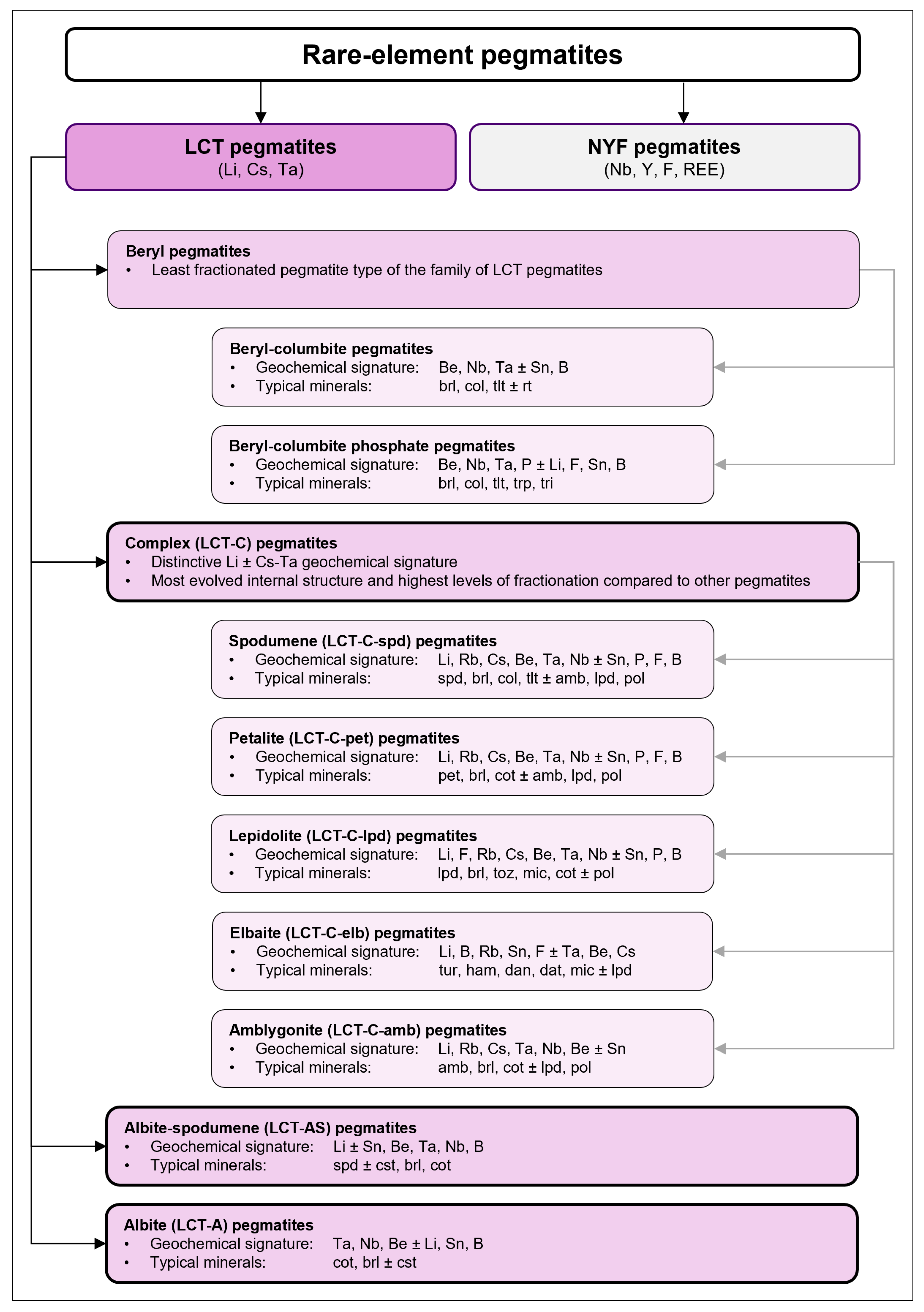

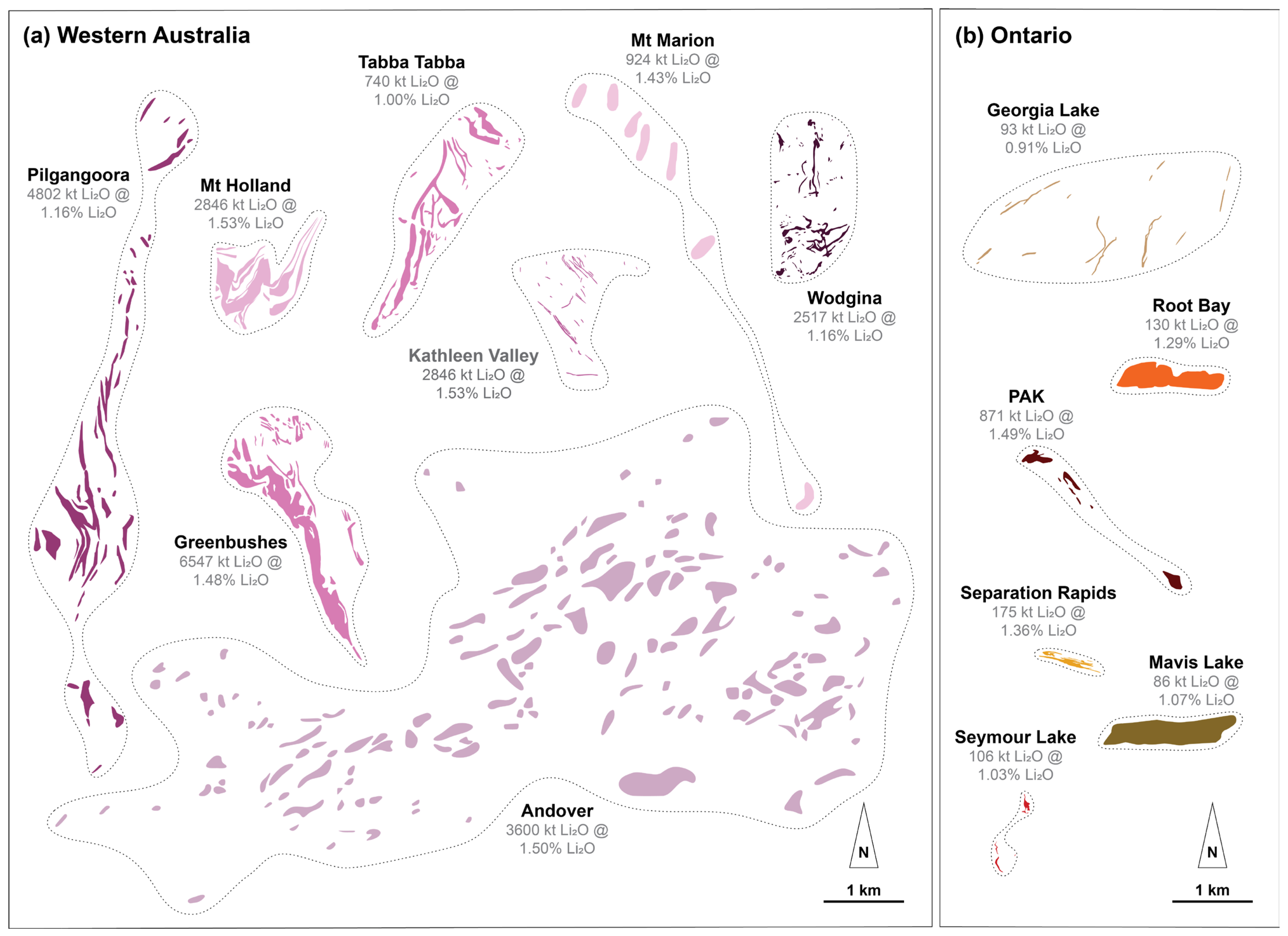
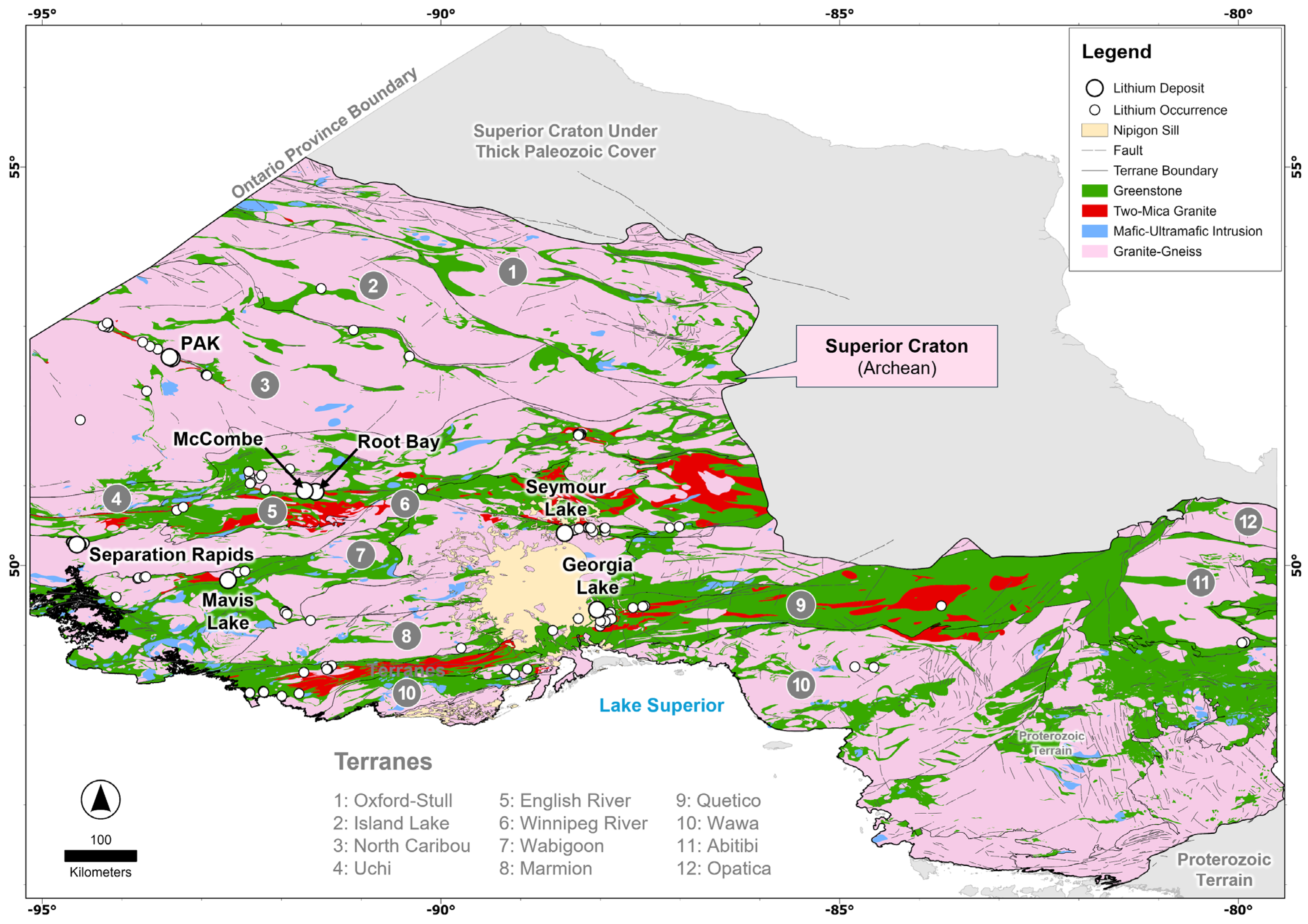

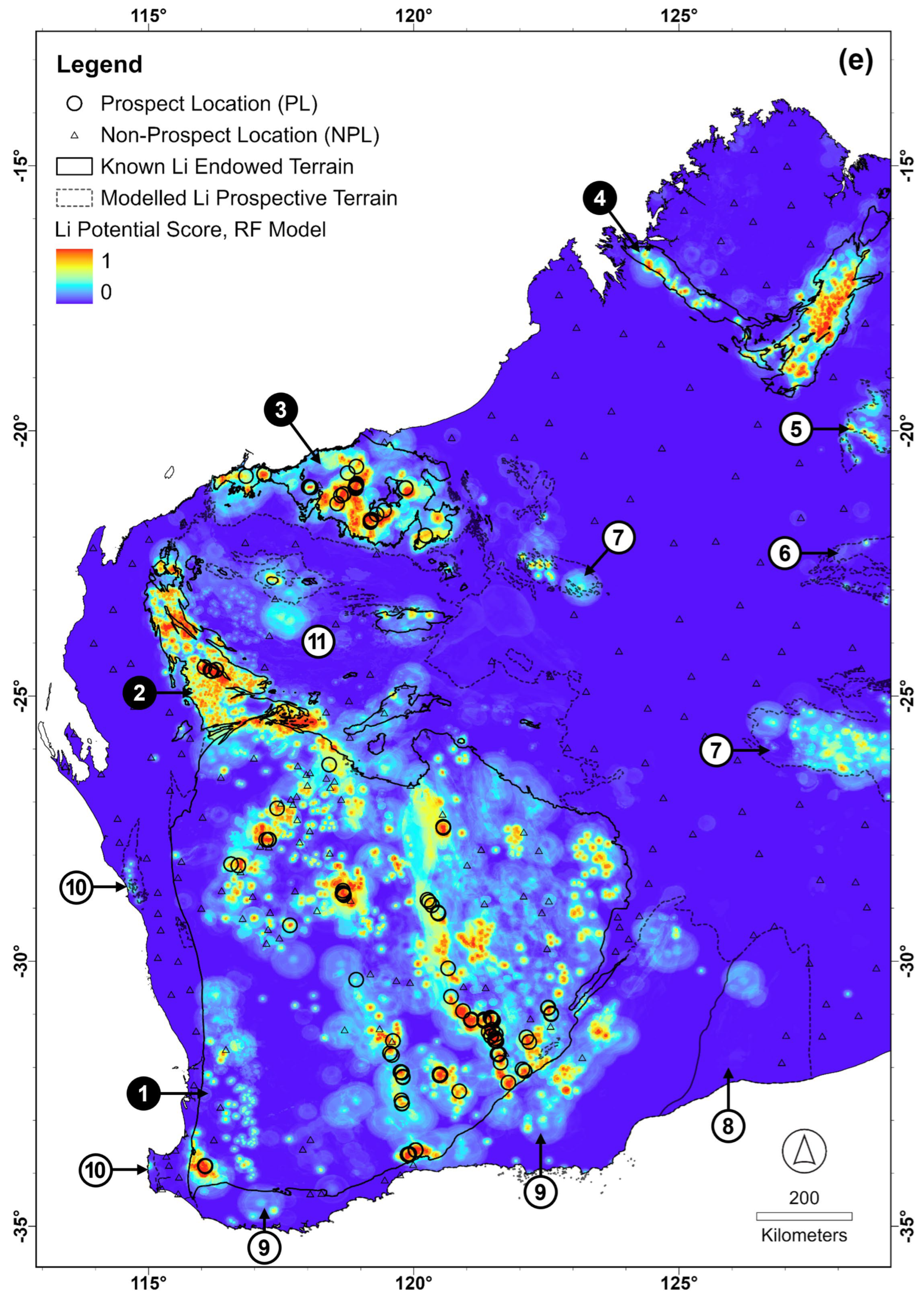
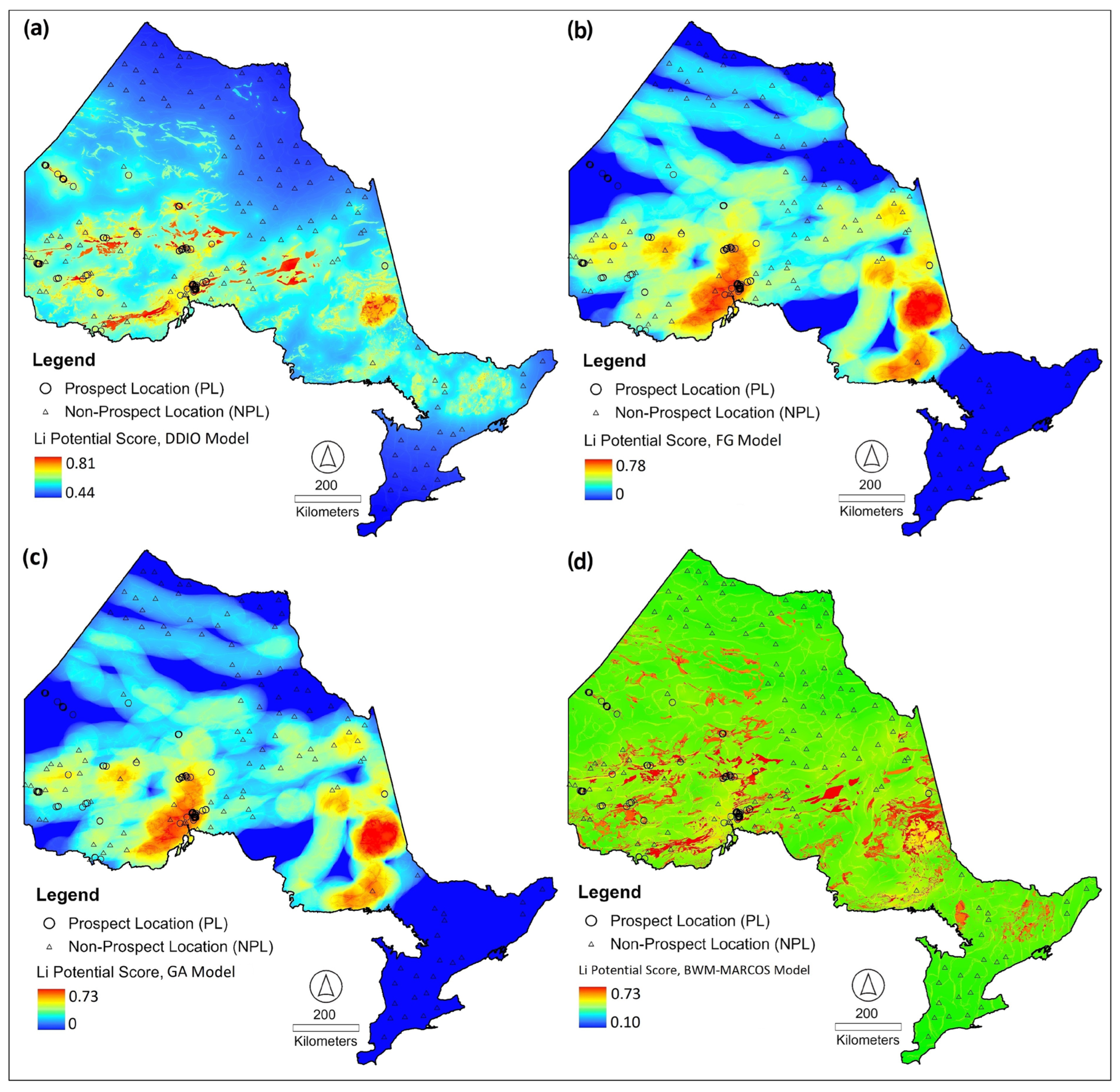
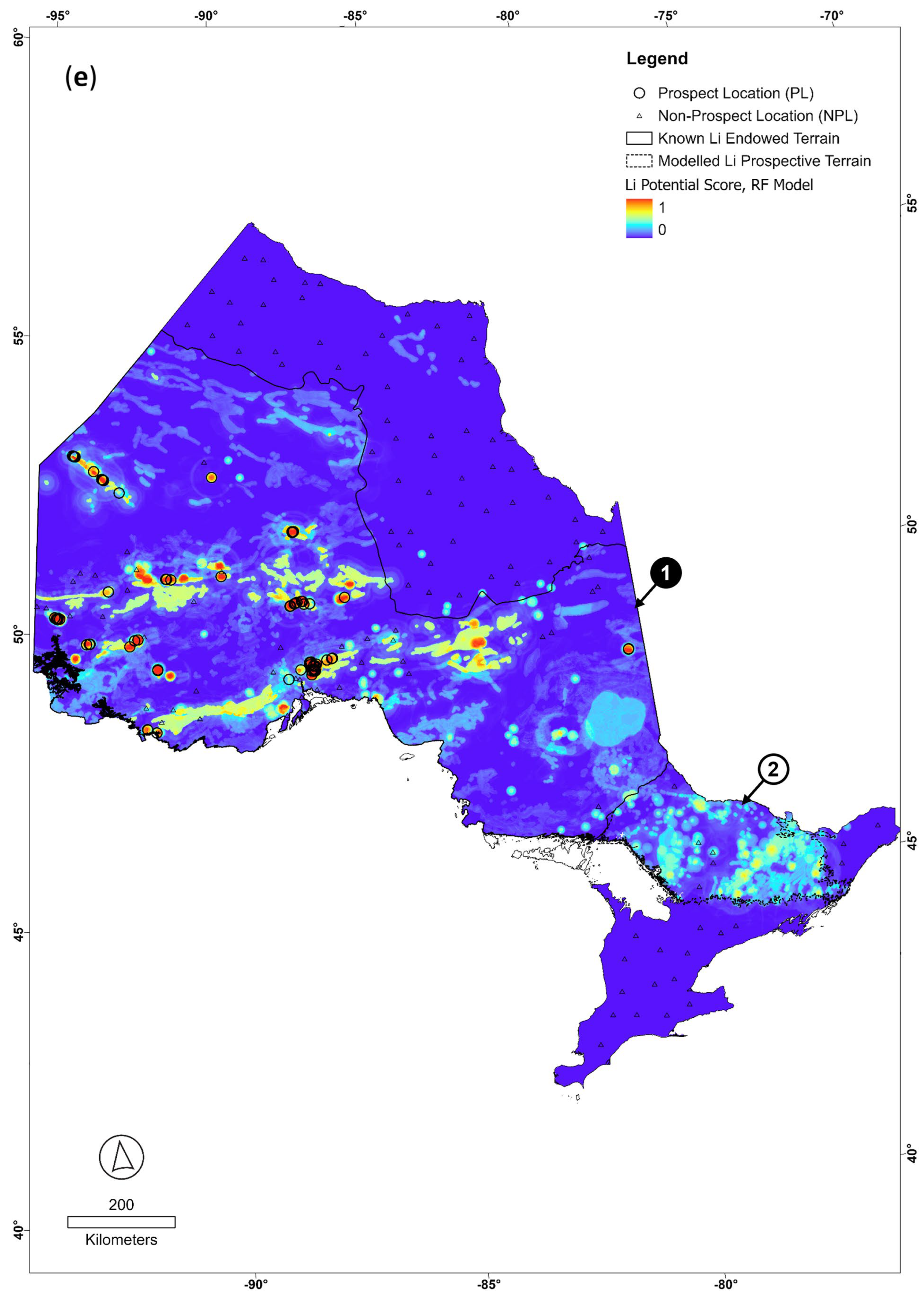
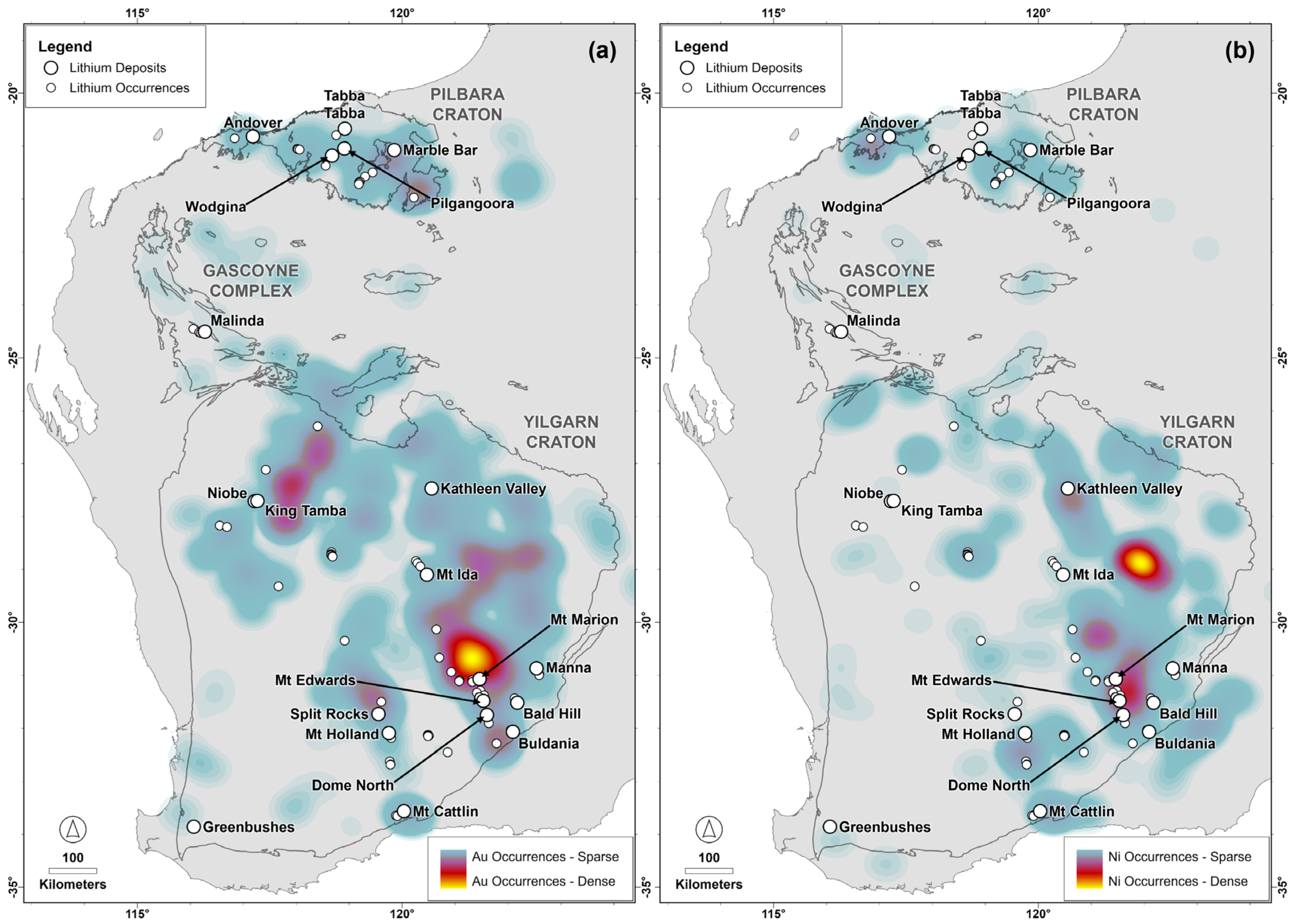

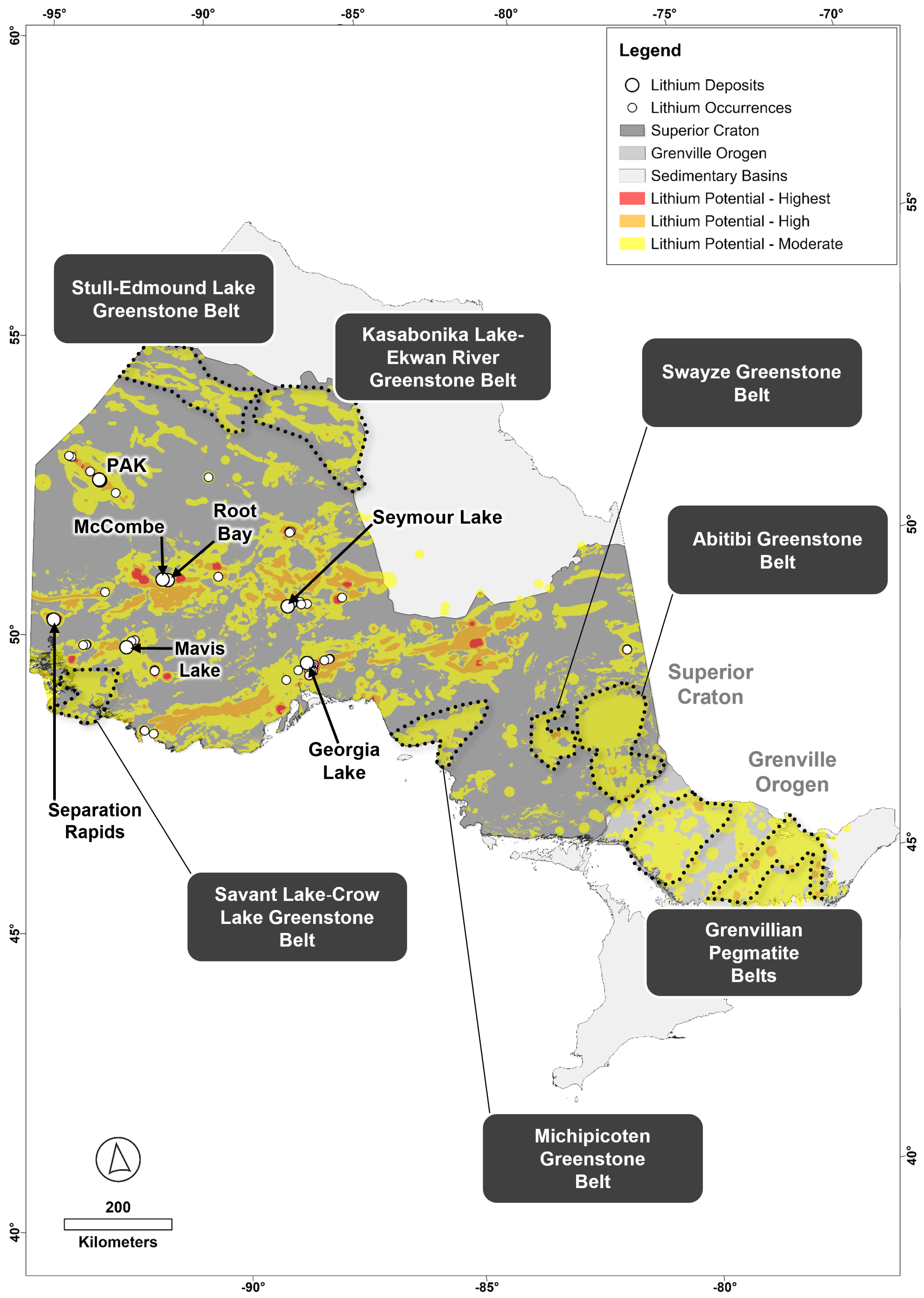

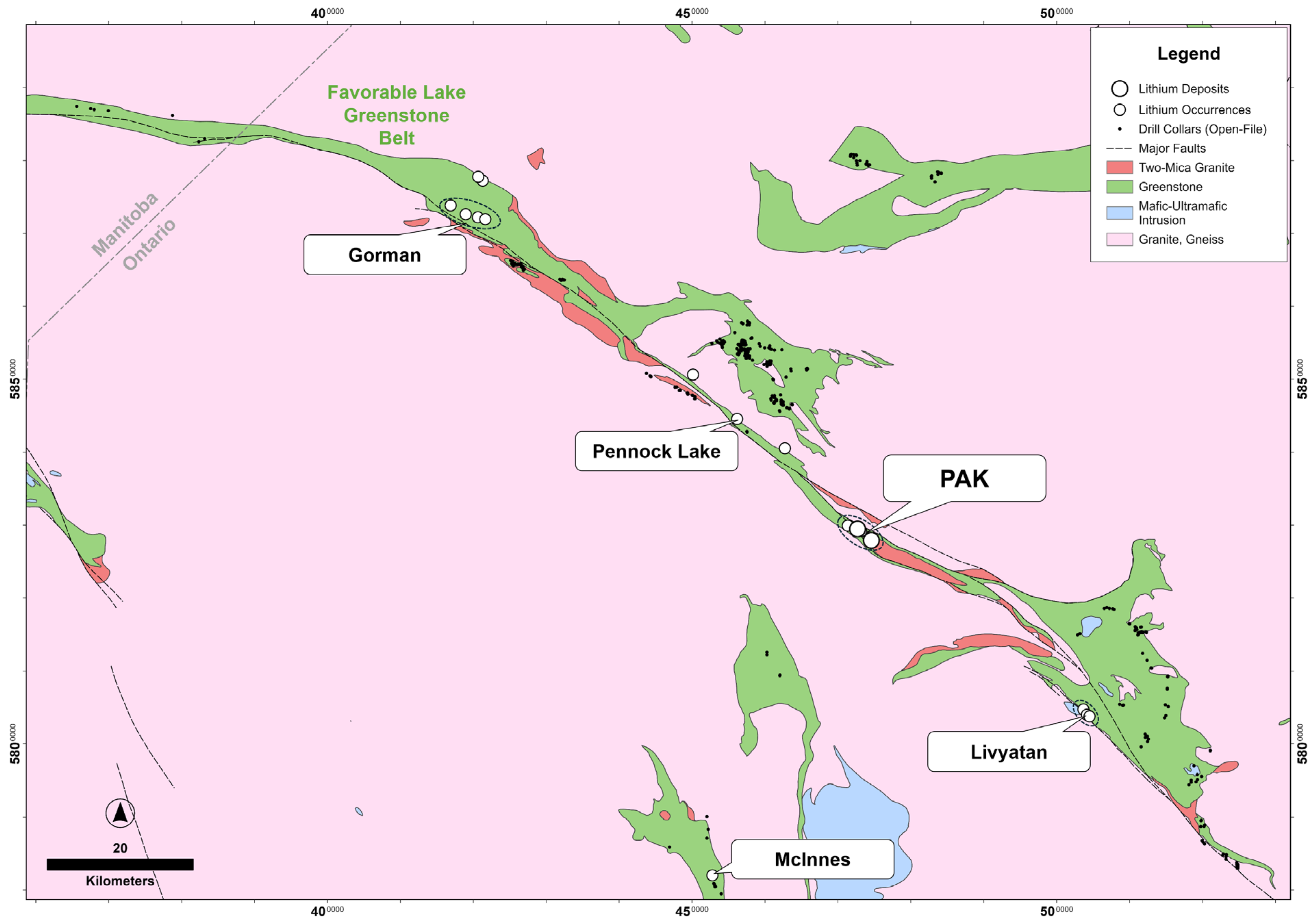
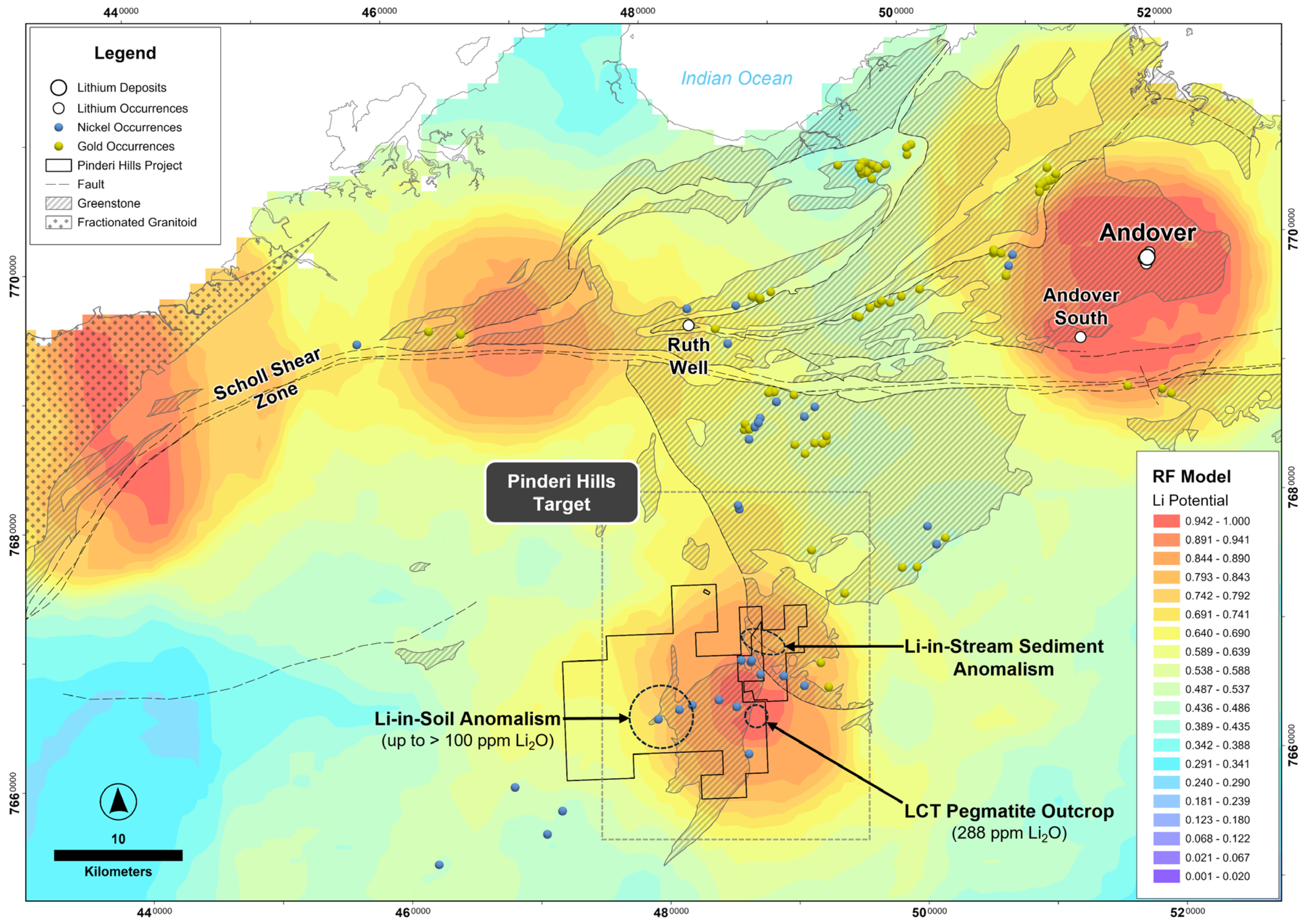
| Critical Processes | Constituent Processes | Targeting Criteria | Targeting Elements and Signatures (Predictor Maps/Spatial Proxies) |
|---|---|---|---|
| Source | LCT pegmatites are products of the extreme fractionation of granitic magmas and acquire most of their compositional attributes at source. Their genesis requires a high degree of crustal melting to form fertile granitic magmas as a source for fluids, metals, and energy to drive the mineral system. The genetic link between LCT pegmatites and S-type or evolved I-type granitic magmas and their tectonic settings is relatively well established; although, Archean tectonic processes are subject to ongoing dispute (i.e., subduction versus sagduction and/or drip tectonics). | Convergent plate margin settings (Phanerozoic, Proterozoic ± Archean) or continental rift zones marked by greenstone belts (Archean). Granite stocks, plutons, or batholiths of S-type or evolved I-type affinity. | Proximity to fractionated granitic rock units. 1,2 Proximity to pegmatitic or pegmatite-bearing rock units. |
| Transport | Granitic melts ascent into the upper crust along zones of structural weakness. Upper crustal fault-fracture systems act as conduits for focusing large volumes of melts and fluids over short periods of time | First- and second-order fault systems. High degree of crustal permeability. | Domains of greater density of Bouguer gravity breaks. Proximity to Bouguer gravity breaks. Domains of greater density of RTP magnetic breaks. Domains of greater density of major crustal boundaries. Proximity to faults and lineaments. |
| Trap | Given their affinity with convergent plate margin settings (Phanerozoic, Proterozoic ± Archean) or continental rift zones (Archean) and emplacement of source granites at mid-crustal levels, LCT pegmatites cut and solidify in metamorphosed supra-crustal rocks. | Metamorphosed terrains of greenschist to amphibolite facies grade. | Proximity to metamorphic rocks. |
| LCT pegmatites have a distinct preference for mafic or ultramafic host rocks; this is likely a function of favorable physico-chemical parameters that serve to enhance trap and depositional processes. Competency contrasts may give rise to local zones of dilation and permeability, focusing fluid flow at or close to lithological contacts. | Mafic and ultramafic rock sequences. Domains of favorable host rheology (competency contrast). | Proximity to mafic–ultramafic rocks. | |
| LCT pegmatites have statistically valid abundance and proximity relationships with gold and nickel occurrences; this is likely a function of loosely comparable transport and trap processes (this study). | Clusters of gold and/or nickel occurrences. | Proximity to Au occurrences. Proximity to Ni occurrences. | |
| Deposition | Concentration of incompatible rare elements and volatiles in residual LCT pegmatite melts. LCT pegmatite melt solidification, magmatic–hydrothermal transition, and rare metals mineralization. | Confirmed LCT pegmatites. Presence of indicator minerals (e.g., tourmaline or garnet in pegmatites or holmquistite in country rocks). Litho-geochemical dispersion halos (e.g., Li, Rb, Cs) in country rocks. Geochemical anomalism (e.g., Li, Cs, Ta). Fractionation indicators (e.g., very low K/Rb, K/Cs, or Nb/Ta ratios as revealed by rock chip geochemistry or portable XRF spot readings). | Proximity to mapped pegmatites. Proximity to LCT pegmatite indicator minerals. 3 |
| Preservation | Metasomatic alteration processes can result in the selective to complete replacement of primary minerals (e.g., spodumene, petalite) by secondary minerals (e.g., albite, cookeite, or kaolinite) and the removal of deleterious elements. | Sub-solidus hydrothermal alteration. Post-magmatic hydrothermal activity. | Not mappable at the scale of this investigation. |
| Tectonic and/or climatic and erosional forces can have positive (e.g., LCT pegmatite exhumation) or negative (e.g., complete destruction of LCT pegmatites) effects. | For example, topographic highs formed by outcropping, weathering-resistant LCT pegmatites. |
| Spatial Proxy | Pr (%) | Oa (%) | Nd | AUC | ln(Nd) |
|---|---|---|---|---|---|
| Proximity to mapped pegmatites | 86 | 14 | 6.14 | 0.95 | 1.82 |
| Proximity to LCT pegmatite indicator minerals | 84 | 16 | 5.25 | 0.92 | 1.66 |
| Proximity to mafic–ultramafic rocks | 78 | 22 | 3.55 | 0.94 | 1.27 |
| Proximity to Au occurrences | 76 | 24 | 3.17 | 0.84 | 1.15 |
| Proximity to Ni occurrences | 74 | 26 | 2.85 | 0.86 | 1.05 |
| Proximity to fractionated granitic rock units | 70 | 30 | 2.33 | 0.81 | 0.85 |
| Proximity to pegmatitic or pegmatite-bearing rock units | 69 | 31 | 2.23 | 0.84 | 0.80 |
| Proximity to faults and lineaments | 67 | 33 | 2.03 | 0.67 | 0.71 |
| Domains of greater density of RTP magnetic breaks | 65 | 35 | 1.86 | 0.66 | 0.62 |
| Domains of greater density of Bouguer gravity breaks | 63 | 37 | 1.70 | 0.66 | 0.53 |
| Domains of greater density of major crustal boundaries | 58 | 42 | 1.38 | 0.59 | 0.32 |
| Proximity to metamorphic rocks | 57 | 43 | 1.33 | 0.55 | 0.28 |
| Spatial Proxy | Pr (%) | Oa (%) | Nd | AUC | ln(Nd) |
|---|---|---|---|---|---|
| Proximity to LCT pegmatite indicator minerals | 89 | 11 | 8.09 | 0.96 | 2.09 |
| Proximity to mapped pegmatites | 87 | 13 | 6.69 | 0.94 | 1.90 |
| Proximity to fractionated granitic rock units | 86 | 14 | 6.14 | 0.94 | 1.82 |
| Proximity to Au occurrences | 69 | 31 | 2.23 | 0.76 | 0.80 |
| Domains of greater density of major crustal boundaries | 68 | 32 | 2.13 | 0.73 | 0.75 |
| Proximity to mafic–ultramafic rocks | 65 | 35 | 1.86 | 0.90 | 0.62 |
| Proximity to Ni occurrences | 68 | 32 | 2.13 | 0.78 | 0.75 |
| Proximity to Bouguer gravity breaks | 51 | 49 | 1.04 | 0.54 | 0.04 |
| Competent Spatial Proxies | Parameters | ||||||
|---|---|---|---|---|---|---|---|
| Pm | Pn | 100-Pm | 100-Pn | TPr | FPr | Op | |
| Proximity to mapped pegmatites (DC8) | 86 | 49 | 14 | 51 | 0.86 | 0.49 | 0.37 |
| Proximity to LCT pegmatite indicator minerals (DC10) | 84 | 52 | 16 | 48 | 0.84 | 0.52 | 0.32 |
| Proximity to mafic–ultramafic rocks (DC9) | 78 | 50 | 22 | 50 | 0.78 | 0.50 | 0.28 |
| Proximity to Au occurrences (DC11) | 76 | 52 | 24 | 48 | 0.76 | 0.52 | 0.24 |
| Proximity to Ni occurrences (DC12) | 74 | 50 | 26 | 50 | 0.74 | 0.50 | 0.24 |
| Proximity to pegmatitic or pegmatite-bearing rock units (DC7) | 69 | 52 | 31 | 48 | 0.69 | 0.52 | 0.17 |
| Proximity to fractionated granitic rock units (DC1) | 70 | 53 | 30 | 47 | 0.70 | 0.53 | 0.17 |
| Domains of greater density of RTP magnetic breaks (DC6) | 65 | 50 | 35 | 50 | 0.65 | 0.50 | 0.15 |
| Domains of greater density of Bouguer gravity breaks (DC5) | 63 | 50 | 37 | 50 | 0.63 | 0.50 | 0.13 |
| Proximity to faults and lineaments (DC4) | 67 | 55 | 33 | 45 | 0.67 | 0.55 | 0.12 |
| Proximity to metamorphic rocks (DC2) | 57 | 47 | 43 | 53 | 0.57 | 0.47 | 0.10 |
| Domains of greater density of major crustal boundaries (DC3) | 58 | 49 | 42 | 51 | 0.58 | 0.49 | 0.09 |
| Competent Spatial Proxies | Parameters | ||||||
|---|---|---|---|---|---|---|---|
| Pm | Pn | 100-Pm | 100-Pn | TPr | FPr | Op | |
| Proximity to mapped pegmatites (DC8) | 87 | 44 | 13 | 56 | 0.87 | 0.44 | 0.43 |
| Proximity to LCT pegmatite indicator minerals (DC4) | 89 | 47 | 11 | 53 | 0.89 | 0.47 | 0.42 |
| Proximity to fractionated granitic rock units (DC1) | 86 | 47 | 14 | 53 | 0.86 | 0.47 | 0.39 |
| Proximity to mafic–ultramafic rocks (DC3) | 65 | 38 | 35 | 62 | 0.65 | 0.38 | 0.27 |
| Proximity to Au occurrences (DC5) | 69 | 43 | 31 | 57 | 0.69 | 0.43 | 0.26 |
| Proximity to Ni occurrences (DC6) | 68 | 43 | 32 | 57 | 0.68 | 0.43 | 0.25 |
| Domains of greater density of major crustal boundaries (DC7) | 68 | 48 | 32 | 52 | 0.68 | 0.48 | 0.20 |
| Proximity to Bouguer gravity breaks (DC2) | 51 | 50 | 49 | 50 | 0.51 | 0.50 | 0.01 |
| Fuzzy Gamma | Geometric Average | Index Overlay | BWM-MARCOS | RF | |
|---|---|---|---|---|---|
| Pm (Hits) | 66 | 65 | 91 | 93 | 98 |
| Pn (False Alarms) | 48 | 48 | 50 | 48 | 46 |
| 100-Pm (Misses) | 34 | 35 | 9 | 7 | 2 |
| 100-Pn (Correct Rejection) | 52 | 52 | 50 | 52 | 54 |
| True Positive Rate (TPr) | 0.66 | 0.65 | 0.91 | 0.93 | 0.98 |
| False Positive Rate (FPr) | 0.48 | 0.48 | 0.50 | 0.48 | 0.46 |
| Overall Performance (Op) | 0.18 | 0.17 | 0.41 | 0.45 | 0.52 |
| Fuzzy Gamma | Geometric Average | Index Overlay | BWM-MARCOS | RF | |
|---|---|---|---|---|---|
| Pm (Hits) | 75 | 75 | 92 | 88 | 98 |
| Pn (False Alarms) | 49 | 49 | 43 | 49 | 37 |
| 100-Pm (Misses) | 25 | 25 | 8 | 12 | 2 |
| 100-Pn (Correct Rejection) | 51 | 51 | 57 | 51 | 63 |
| True Positive Rate (TPr) | 0.75 | 0.75 | 0.92 | 0.88 | 0.98 |
| False Positive Rate (FPr) | 0.49 | 0.49 | 0.43 | 0.49 | 0.37 |
| Overall Performance (Op) | 0.26 | 0.26 | 0.49 | 0.39 | 0.61 |
Disclaimer/Publisher’s Note: The statements, opinions and data contained in all publications are solely those of the individual author(s) and contributor(s) and not of MDPI and/or the editor(s). MDPI and/or the editor(s) disclaim responsibility for any injury to people or property resulting from any ideas, methods, instructions or products referred to in the content. |
© 2025 by the authors. Licensee MDPI, Basel, Switzerland. This article is an open access article distributed under the terms and conditions of the Creative Commons Attribution (CC BY) license (https://creativecommons.org/licenses/by/4.0/).
Share and Cite
Kreuzer, O.P.; Roshanravan, B. Transforming LCT Pegmatite Targeting Models into AI-Powered Predictive Maps of Lithium Potential for Western Australia and Ontario: Approach, Results and Implications. Minerals 2025, 15, 397. https://doi.org/10.3390/min15040397
Kreuzer OP, Roshanravan B. Transforming LCT Pegmatite Targeting Models into AI-Powered Predictive Maps of Lithium Potential for Western Australia and Ontario: Approach, Results and Implications. Minerals. 2025; 15(4):397. https://doi.org/10.3390/min15040397
Chicago/Turabian StyleKreuzer, Oliver P., and Bijan Roshanravan. 2025. "Transforming LCT Pegmatite Targeting Models into AI-Powered Predictive Maps of Lithium Potential for Western Australia and Ontario: Approach, Results and Implications" Minerals 15, no. 4: 397. https://doi.org/10.3390/min15040397
APA StyleKreuzer, O. P., & Roshanravan, B. (2025). Transforming LCT Pegmatite Targeting Models into AI-Powered Predictive Maps of Lithium Potential for Western Australia and Ontario: Approach, Results and Implications. Minerals, 15(4), 397. https://doi.org/10.3390/min15040397












